Reliability Analysis of AlGaN-Based Deep UV-LEDs
Abstract
1. Introduction
2. Fabrication of DUV-LEDs
3. Degradation Due to Current Stress
4. Degradation Due to Defect Creation
5. Degradation Effects on C–V Characteristics
6. Degradation Effects on I–V Characteristics
7. Structural Design Strategies for Better Reliability
8. AlGaN near UL-LEDs with Enhanced Reliability: A SARS-CoV-2 Solution
9. Degradation Mechanisms under Different Measurement Conditions
10. Concluding Remarks
- There are several factors that affect the reliability and lifetime of an LED and the most prominent factor is the creation of point defects due to current stress applied for a given time and these point defects affect both the electronic and optical properties of the LED, especially at lower wavelength range, as mentioned above.
- The early aging of the LEDs is caused by the production of nonradiative centers in the active region of the devices as a consequence of lowering the internal quantum efficiency. When there is a consistent supply of operational current, the optical power is lowered. While the higher current densities accelerate the optical power degradation. The time dependence of optical power of near UV LEDs is found to be influenced by a scaling factor that is the cube of the operating current density.
- Below the startup voltage, the leakage current rises with the extension in the operational time. In comparison to higher currents, the low-current areas facilitate the changing of the emission power with respect to driving current.
- In the aging process, lowering of the emission intensity go along with the growth of the tunneling current, excessive nitrogen-vacancy concentration, and fragmentary compensation of the p-doping. However, the aging process remain unaffected on the lifespan of the carriers in QWs as well as p-cladding.
- The measurement of degradation of the electrical characteristics of the LEDs can be ensured by high-temperature stress. Also, it helps in the rise of the operating voltage of the devices. The degradation rate was found to rise up with increasing junction temperature level. The widening of the active region (i.e., p-contact) can raise the reliability level. The modified carrier distribution i.e., excessive QWs in the active region, can be an effective strategy for the extension of the lifetime.
- The production of defects generates the energy levels within the bandgap. This allows the electrons from these levels to jump up to the conduction band (CB), giving rise to a photocurrent, which is the main characteristic of presence of imperfections in optoelectronic devices.
- For devices with enhanced Al content, emission bands associated with the optical transitions in the cladding give rise to nitrogen vacancies. The evolution of the emission band indicates the stronger influence of the N vacancies in aging process, as it facilitates the production of defects and high-conductivity channels.
- The current lower than the corresponding startup voltage rises with the square root of time dependence. This suggests the occurrence of a diffusion process, using point defects as a source for giving rise to nonradiative recombination in the LED.
- The substrates containing the heteroepitaxial growth of near UV-LEDs have large lattice imperfections causing dislocation densities and material defect concentration can be larger, so careful optimization of the growth and treatment processes are crucial for obtaining high device performance.
- The degradation shows its manifestation in C–V measurements where the stress causes modification in the charge distribution of the active layer, which creates defectiveness. Stress introduces a charge redistribution in the active layer of the devices, and specifically, a consistent increase in charge concentration in the quantum-well region. This suggests the production and transmission of charged centers within the quantum well region, and explains the influence of degradation process on the position of the semiconductor region.
- In the forward-bias range, the rising aging current reduces the capacitance. The lowering of the peak capacitance with rising stress currents suggests the broadening of the depletion widths for unstressed devices. The barrier capacitance governs the whole capacitance: the LED works under the influence of reverse-bias voltage, whereas for forward-bias voltage, the larger portion is contributed by diffusion capacitance. As the reverse-bias voltage falls, the micro-LED capacitance rises, which points out the surface of the space charge region movement.
- The nonlinearity in the I-V characteristic was not only caused by the p-n junction but also from the non-ohmic nature of the p- and n-contacts. This displays approximately the reverse-biased Schottky behavior. DC stress can also give rise to reverse bias as well as the low-forward bias current components. During stress, the current rise for a given voltage is less than the startup value. Eventually, the I-V characteristic curves indicate the lowering of the drive voltage throughout stress treatment at the peak voltages. Throughout the aging interval, the reverse leakage current rises for the corresponding reverse bias region. However, the leakage current achieves a stable value with a logarithmic dependence on stress duration.
Author Contributions
Funding
Data Availability Statement
Acknowledgments
Conflicts of Interest
References
- Nadarajah, N.; Lei, D.; Richard, M.P.; Yimin, G.; Hua, Y. Performance characteristics of high-power light-emitting diodes. In Proceedings of the Third International Conference on Solid State Lighting, San Diego, CA, USA, 5–7 August 2003; SPIE: Nellingham, WA, USA, 2004. [Google Scholar]
- Chang, M.-H.; Das, D.; Varde, P.V.; Pecht, M. Light emitting diodes reliability review. Microelectron. Reliab. 2012, 52, 762–782. [Google Scholar] [CrossRef]
- Meneghini, M.; Tazzoli, A.; Mura, G.; Meneghesso, G.; Zanoni, E. A Review on the Physical Mechanisms that Limit the Reliability of GaN-Based LEDs. IEEE Trans. Electron Devices 2010, 57, 108–118. [Google Scholar] [CrossRef]
- Liang, F.; Feng, M.; Huang, Y.; Sun, X.; Zhan, X.; Liu, J.; Sun, Q.; Wang, R.; Ge, X.; Ning, J.; et al. AlGaN-based Schottky barrier deep ultraviolet photodetector grown on Si substrate. Opt. Express 2020, 28, 17188–17195. [Google Scholar] [CrossRef] [PubMed]
- So, H.; Lim, J.; Suria, A.J.; Senesky, D.G. Highly antireflective AlGaN/GaN ultraviolet photodetectors using ZnO nanorod arrays on inverted pyramidal surfaces. Appl. Surf. 2017, 409, 91–96. [Google Scholar] [CrossRef]
- Monroy, E.; Calle, F.; Pau, J.L.; Muñoz, E.; Omnès, F.; Beaumont, B.; Gibart, P. AlGaN-based UV photodetectors. J. Cryst. Growth 2001, 230, 537–543. [Google Scholar] [CrossRef]
- Pernot, C.; Hirano, A.; Iwaya, M.; Detchprohm, T.; Amano, H.; Akasaki, I. Low-Intensity Ultraviolet Photodetectors Based on AlGaN. Jpn. J. Appl. Phys. 1999, 38, L487–L489. [Google Scholar] [CrossRef]
- Nagasawa, Y.; Hirano, A. A Review of AlGaN-Based Deep-Ultraviolet Light-Emitting Diodes on Sapphire. Appl. Sci. 2018, 8, 1264. [Google Scholar] [CrossRef]
- Kneissl, M.; Seong, T.-Y.; Han, J.; Amano, H. The emergence and prospects of deep-ultraviolet light-emitting diode technologies. Nat. Photonics 2019, 13, 233–244. [Google Scholar] [CrossRef]
- Shur, M.S.; Gaska, R. Deep-Ultraviolet Light-Emitting Diodes. IEEE Trans. Electron Devices 2010, 57, 12–25. [Google Scholar] [CrossRef]
- Khan, U.; Nairan, A.; Gao, J.; Zhang, Q. Current Progress in 2D Metal–Organic Frameworks for Electrocatalysis. Small Struct. 2022, 2200109. [Google Scholar] [CrossRef]
- Hsu, T.-C.; Teng, Y.-T.; Yeh, Y.-W.; Fan, X.; Chu, K.-H.; Lin, S.-H.; Yeh, K.-K.; Lee, P.-T.; Lin, Y.; Chen, Z.; et al. Perspectives on UVC LED: Its Progress and Application. Photonics 2021, 8, 196. [Google Scholar] [CrossRef]
- Li, J.; Wang, J.; Yi, X.; Liu, Z.; Wei, T.; Yan, J.; Xue, B. III-Nitrides Light Emitting Diodes: Technology and Applications; Springer: Berlin/Heidelberg, Germany, 2020; Volume 306. [Google Scholar] [CrossRef]
- Shatalov, M.; Lunev, A.; Hu, X.; Bilenko, O.; Gaska, I.; Sun, W.; Yang, J.; Dobrinsky, A.; Bilenko, Y.; Gaska, R.; et al. Performance and Applications of Deep UV LED. In Frontiers in Electronics; Selected Topics in Electronics and Systems; World Scientific: Singapore, 2013; Volume 53, pp. 93–107. [Google Scholar]
- Usman, M.; Malik, S.; Khan, M.A.; Hirayama, H. Suppressing the efficiency droop in AlGaN-based UVB LEDs. Nanotechnology 2021, 32, 215703. [Google Scholar] [CrossRef] [PubMed]
- Khan, M.A.; Itokazu, Y.; Maeda, N.; Jo, M.; Yamada, Y.; Hirayama, H. External Quantum Efficiency of 6.5% at 300 nm Emission and 4.7% at 310 nm Emission on Bare Wafer of AlGaN-Based UVB LEDs. ACS Appl. Electron. Mater. 2020, 2, 1892–1907. [Google Scholar] [CrossRef]
- Liu, D.; Cho, S.J.; Park, J.; Seo, J.-H.; Dalmau, R.; Zhao, D.; Kim, K.; Gong, J.; Kim, M.; Lee, I.-K.; et al. 229 nm UV LEDs on aluminum nitride single crystal substrates using p-type silicon for increased hole injection. Appl. Phys. Lett. 2018, 112, 081101. [Google Scholar] [CrossRef]
- Lin, S.-H.; Tseng, M.-C.; Peng, K.-W.; Lai, S.; Shen, M.-C.; Horng, R.-H.; Lien, S.-Y.; Wuu, D.-S.; Kuo, H.-C.; Wu, T.; et al. Enhanced external quantum efficiencies of AlGaN-based deep-UV LEDs using reflective passivation layer. Opt. Express 2021, 29, 37835–37844. [Google Scholar] [CrossRef]
- Tran, B.T.; Maeda, N.; Jo, M.; Inoue, D.; Kikitsu, T.; Hirayama, H. Performance Improvement of AlN Crystal Quality Grown on Patterned Si(111) Substrate for Deep UV-LED Applications. Sci. Rep. 2016, 6, 35681. [Google Scholar] [CrossRef]
- Kashima, Y.; Maeda, N.; Matsuura, E.; Jo, M.; Iwai, T.; Morita, T.; Kokubo, M.; Tashiro, T.; Kamimura, R.; Osada, Y.; et al. High external quantum efficiency (10%) AlGaN-based deep-ultraviolet light-emitting diodes achieved by using highly reflective photonic crystal on p-AlGaN contact layer. Appl. Phys. Express 2017, 11, 012101. [Google Scholar] [CrossRef]
- Zhang, Z.-H.; Huang Chen, S.-W.; Chu, C.; Tian, K.; Fang, M.; Zhang, Y.; Bi, W.; Kuo, H.-C. Nearly Efficiency-Droop-Free AlGaN-Based Ultraviolet Light-Emitting Diodes with a Specifically Designed Superlattice p-Type Electron Blocking Layer for High Mg Doping Efficiency. Nanoscale Res. Lett. 2018, 13, 122. [Google Scholar] [CrossRef]
- Nagamatsu, K.; Liu, X.; Uesugi, K.; Miyake, H. Improved emission intensity of UVC-LEDs from using strain relaxation layer on sputter-annealed AlN. Jpn. J. Appl. Phys. 2019, 58, SCCC07. [Google Scholar] [CrossRef]
- Hu, J.; Zhang, J.; Zhang, Y.; Zhang, H.; Long, H.; Chen, Q.; Shan, M.; Du, S.; Dai, J.; Chen, C. Enhanced Performance of AlGaN-Based Deep Ultraviolet Light-Emitting Diodes with Chirped Superlattice Electron Deceleration Layer. Nanoscale Res. Lett. 2019, 14, 347. [Google Scholar] [CrossRef]
- Khan, M.A.; Maeda, N.; Yun, J.; Jo, M.; Yamada, Y.; Hirayama, H. Achieving 9.6% efficiency in 304 nm p-AlGaN UVB LED via increasing the holes injection and light reflectance. Sci. Rep. 2022, 12, 2591. [Google Scholar] [CrossRef] [PubMed]
- Khan, M.A.; Maeda, N.; Jo, M.; Akamatsu, Y.; Tanabe, R.; Yamada, Y.; Hirayama, H. 13 mW operation of a 295–310 nm AlGaN UV-B LED with a p-AlGaN transparent contact layer for real world applications. J. Mater. Chem. C 2019, 7, 143–152. [Google Scholar] [CrossRef]
- Ge, S.; Dai, J.; Gao, N.; Lu, S.; Li, P.; Huang, K.; Liu, B.; Kang, J.; Zhang, R.; Zheng, Y. Optical Performance of Top-Down Fabricated AlGaN Nanorod Arrays with Multi-Quantum Wells Embedded. Nanoscale Res. Lett. 2019, 14, 170. [Google Scholar] [CrossRef] [PubMed]
- Sulmoni, L.; Mehnke, F.; Mogilatenko, A.; Guttmann, M.; Wernicke, T.; Kneissl, M. Electrical properties and microstructure formation of V/Al-based n-contacts on high Al mole fraction n-AlGaN layers. Photon. Res. 2020, 8, 1381–1387. [Google Scholar] [CrossRef]
- Wang, T.-Y.; Lai, W.-C.; Sie, S.-Y.; Chang, S.-P.; Kuo, C.-H.; Sheu, J.-K.; Bow, J.-S. AlGaN-Based Deep Ultraviolet Light-Emitting Diodes with Thermally Oxidized AlxGa2–xO3 Sidewalls. ACS Omega 2022, 7, 15027–15036. [Google Scholar] [CrossRef]
- Yoshikawa, A.; Hasegawa, R.; Morishita, T.; Nagase, K.; Yamada, S.; Grandusky, J.; Mann, J.; Miller, A.; Schowalter, L.J. Improve efficiency and long lifetime UVC LEDs with wavelengths between 230 and 237 nm. Appl. Phys. Express 2020, 13, 022001. [Google Scholar] [CrossRef]
- Lu, L.; Zhang, X.; Wang, S.; Fan, A.; Chen, S.; Li, C.; Nasir, A.; Zhuang, Z.; Hu, G.; Cui, Y. Impact of composite last quantum barrier on the performance of AlGaN-based deep ultraviolet light-emitting diode. J. Mater. Sci. Mater. Electron. 2021, 32, 18138–18144. [Google Scholar] [CrossRef]
- Hrong, R.-H.; Zeng, Y.-Y.; Wang, W.-K.; Tsai, C.-L.; Fu, Y.-K.; Kuo, W.-H. Transparent electrode design for AlGaN deep-ultraviolet light-emitting diodes. Opt. Express 2017, 25, 32206–32213. [Google Scholar] [CrossRef]
- Chu, C.; Tian, K.; Che, J.; Shao, H.; Kou, J.; Zhang, Y.; Li, Y.; Wang, M.; Zhu, Y.; Zhang, Z.-H. On the origin of enhanced hole injection for AlGaN-based deep ultraviolet light-emitting diodes with AlN insertion layer in p-electron blocking layer. Opt. Express 2019, 27, A620–A628. [Google Scholar] [CrossRef]
- Sung, Y.J.; Kim, M.-S.; Kim, H.; Choi, S.; Kim, Y.H.; Jung, M.-H.; Choi, R.-J.; Moon, Y.-T.; Oh, J.-T.; Jeong, H.-H.; et al. Light extraction enhancement of AlGaN-based vertical type deep-ultraviolet light-emitting-diodes by using highly reflective ITO/Al electrode and surface roughening. Opt. Express 2019, 27, 29930–29937. [Google Scholar] [CrossRef]
- Kaneda, M.; Pernot, C.; Nagasawa, Y.; Hirano, A.; Ippommatsu, M.; Honda, Y.; Amano, H.; Akasaki, I. Uneven AlGaN multiple quantum well for deep-ultraviolet LEDs grown on macrosteps and impact on electroluminescence spectral output. Jpn. J. Appl. Phys. 2017, 56, 061002. [Google Scholar] [CrossRef]
- Takano, T.; Mino, T.; Sakai, J.; Noguchi, N.; Tsubaki, K.; Hirayama, H. Deep-ultraviolet light-emitting diodes with external quantum efficiency higher than 20% at 275 nm achieved by improving light-extraction efficiency. Appl. Phys. Express 2017, 10, 031002. [Google Scholar] [CrossRef]
- Glaab, J.; Ruschel, J.; Mehnke, F.; Lapeyrade, M.; Guttmann, M.; Wernicke, T.; Weyers, M.; Einfeldt, S.; Kneissl, M. Degradation behavior of AlGaN-based 233 nm deep-ultraviolet light emitting diodes. Semicond. Sci. Technol. 2018, 33, 095017. [Google Scholar] [CrossRef]
- Narendran, N.; Gu, Y.; Freyssinier, J.P.; Yu, H.; Deng, L. Solid-state lighting: Failure analysis of white LEDs. J. Cryst. Growth 2004, 268, 449–456. [Google Scholar] [CrossRef]
- Yang, X.; Sun, B.; Wang, Z.; Qian, C.; Ren, Y.; Yang, D.; Feng, Q. An Alternative Lifetime Model for White Light Emitting Diodes under Thermal–Electrical Stresses. Materials 2018, 11, 817. [Google Scholar] [CrossRef] [PubMed]
- Meneghini, M.; Trevisanello, L.; Meneghesso, G.; Zanoni, E. A Review on the Reliability of GaN-Based LEDs. IEEE Trans. Device Mater. Reliab. 2008, 8, 323–331. [Google Scholar] [CrossRef]
- Meneghini, M.; Trivellin, N.; Trevisanello, L.; Lunev, A.; Jinwei, Y.; Bilenko, Y.; Wenhong, S.; Shatalov, M.; Gaska, R.; Zanoni, E.; et al. Combined optical and electrical analysis of AlGaN-based deep-UV LEDs reliability. In Proceedings of the 2008 IEEE International Reliability Physics Symposium, Pasadena, CA, USA, 27 April–1 May 2008; pp. 441–445. [Google Scholar]
- Buso, S.; Spiazzi, G.; Meneghini, M.; Meneghesso, G. Performance Degradation of High-Brightness Light Emitting Diodes Under DC and Pulsed Bias. IEEE Trans. Device Mater. Reliab. 2008, 8, 312–322. [Google Scholar] [CrossRef]
- Rossi, F.; Pavesi, M.; Meneghini, M.; Salviati, G.; Manfredi, M.; Meneghesso, G.; Castaldini, A.; Cavallini, A.; Rigutti, L.; Strass, U.; et al. Influence of short-term low current dc aging on the electrical and optical properties of InGaN blue light-emitting diodes. J. Appl. Phys. 2006, 99, 053104. [Google Scholar] [CrossRef]
- Shao, X.; Lu, H.; Chen, D.; Xie, Z.; Zhang, R.; Zheng, Y. Efficiency droop behavior of direct current aged GaN-based blue light-emitting diodes. Appl. Phys. Lett. 2009, 95, 163504. [Google Scholar] [CrossRef]
- Huang, L.; Yu, T.; Chen, Z.; Qin, Z.; Yang, Z.; Zhang, G. Different degradation behaviors of InGaN/GaN MQWs blue and violet LEDs. J. Lumin. 2009, 129, 1981–1984. [Google Scholar] [CrossRef]
- Meneghesso, G.; Levada, S.; Zanoni, E.; Podda, S.; Mura, G.; Vanzi, M.; Cavallini, A.; Castaldini, A.; Du, S.; Eliashevich, I. Failure Modes and Mechanisms of DC-Aged GaN LEDs. Phys. Status Solidi 2002, 194, 389–392. [Google Scholar] [CrossRef]
- Moe, C.G.; Reed, M.L.; Garrett, G.A.; Sampath, A.V.; Alexander, T.; Shen, H.; Wraback, M.; Bilenko, Y.; Shatalov, M.; Yang, J.; et al. Current-induced degradation of high performance deep ultraviolet light emitting diodes. Appl. Phys. Lett. 2010, 96, 213512. [Google Scholar] [CrossRef]
- Xiu, H.; Zhang, Y.; Fu, J.; Ma, Z.; Zhao, L.; Feng, J. Degradation behavior of deep UV-LEDs studied by electro-optical methods and transmission electron microscopy. Curr. Appl. Phys. 2019, 19, 20–24. [Google Scholar] [CrossRef]
- Trivellin, N.; Monti, D.; De Santi, C.; Buffolo, M.; Meneghesso, G.; Zanoni, E.; Meneghini, M. Current induced degradation study on state of the art DUV LEDs. Microelectron. Reliab. 2018, 88–90, 868–872. [Google Scholar] [CrossRef]
- Pinos, A.; Marcinkevičius, S.; Yang, J.; Bilenko, Y.; Shatalov, M.; Gaska, R.; Shur, M.S. Aging of AlGaN quantum well light emitting diode studied by scanning near-field optical spectroscopy. Appl. Phys. Lett. 2009, 95, 181914. [Google Scholar] [CrossRef]
- Pinos, A.; Marcinkevičius, S.; Shur, M.S. High current-induced degradation of AlGaN ultraviolet light emitting diodes. J. Appl. Phys. 2011, 109, 103108. [Google Scholar] [CrossRef]
- Ruschel, J.; Glaab, J.; Beidoun, B.; Ploch, N.L.; Rass, J.; Kolbe, T.; Knauer, A.; Weyers, M.; Einfeldt, S.; Kneissl, M. Current-induced degradation and lifetime prediction of 310 nm ultraviolet light-emitting diodes. Photon. Res. 2019, 7, B36–B40. [Google Scholar] [CrossRef]
- Gong, Z.; Gaevski, M.; Adivarahan, V.; Sun, W.; Shatalov, M.; Asif Khan, M. Optical power degradation mechanisms in AlGaN-based 280 nm deep ultraviolet light-emitting diodes on sapphire. Appl. Phys. Lett. 2006, 88, 121106. [Google Scholar] [CrossRef]
- Ruschel, J.; Glaab, J.; Brendel, M.; Rass, J.; Stölmacker, C.; Lobo-Ploch, N.; Kolbe, T.; Wernicke, T.; Mehnke, F.; Enslin, J.; et al. Localization of current-induced degradation effects in (InAlGa)N-based UV-B LEDs. J. Appl. Phys. 2018, 124, 084504. [Google Scholar] [CrossRef]
- Meneghini, M.; Barbisan, D.; Bilenko, Y.; Shatalov, M.; Yang, J.; Gaska, R.; Meneghesso, G.; Zanoni, E. Defect-related degradation of Deep-UV-LEDs. Microelectron. Reliab. 2010, 50, 1538–1542. [Google Scholar] [CrossRef]
- Chen, Z.; Deng, S.; Li, M.; Su, M.; Zhu, X.; Wang, Y.; Chen, Z.; Deng, J.; Wang, L.; Sun, W. Carrier distribution characteristics of AlGaN-based ultraviolet light-emitting diodes at elevated temperatures. J. Mater. Sci. Mater. Electron. 2022, 33, 17395–17403. [Google Scholar] [CrossRef]
- Deng, S.; Chen, Z.; Li, M.; Su, M.; Zhu, X.; Xiao, K.; Wang, Y.; Deng, J.; Sun, W. Variable temperature thermal droop characteristics of 255 nm UV LED. Appl. Phys. Lett. 2022, 121, 031104. [Google Scholar] [CrossRef]
- Liu, L.; Ling, M.; Yang, J.; Xiong, W.; Jia, W.; Wang, G. Efficiency degradation behaviors of current/thermal co-stressed GaN-based blue light emitting diodes with vertical-structure. J. Appl. Phys. 2012, 111, 093110. [Google Scholar] [CrossRef]
- Monti, D.; Meneghini, M.; Santi, C.D.; Meneghesso, G.; Zanoni, E.; Glaab, J.; Rass, J.; Einfeldt, S.; Mehnke, F.; Enslin, J.; et al. Defect-Related Degradation of AlGaN-Based UV-B LEDs. IEEE Trans. Electron Devices 2017, 64, 200–205. [Google Scholar] [CrossRef]
- Chitnis, A.; Sun, J.; Mandavilli, V.; Pachipulusu, R.; Wu, S.; Gaevski, M.; Adivarahan, V.; Zhang, J.P.; Khan, M.A.; Sarua, A.; et al. Self-heating effects at high pump currents in deep ultraviolet light-emitting diodes at 324 nm. Appl. Phys. Lett. 2002, 81, 3491–3493. [Google Scholar] [CrossRef]
- Lang, D.V. Deep-level transient spectroscopy: A new method to characterize traps in semiconductors. J. Appl. Phys. 1974, 45, 3023–3032. [Google Scholar] [CrossRef]
- Pinos, A.; Marcinkevičius, S.; Yang, J.; Gaska, R.; Shatalov, M.; Shur, M.S. Optical studies of degradation of AlGaN quantum well based deep ultraviolet light emitting diodes. J. Appl. Phys. 2010, 108, 093113. [Google Scholar] [CrossRef]
- Meneghini, M.; Barbisan, D.; Rodighiero, L.; Meneghesso, G.; Zanoni, E. Analysis of the physical processes responsible for the degradation of deep-ultraviolet light emitting diodes. Appl. Phys. Lett. 2010, 97, 143506. [Google Scholar] [CrossRef]
- Meneghini, M.; Trevisanello, L.; Zehnder, U.; Meneghesso, G.; Zanoni, E. Reversible Degradation of Ohmic Contacts on p-GaN for Application in High-Brightness LEDs. IEEE Trans. Electron Devices 2007, 54, 3245–3251. [Google Scholar] [CrossRef]
- Wang, Y.-Z.; Zheng, X.-F.; Zhu, J.-D.; Xu, L.-L.; Xu, S.-R.; Liang, R.-L.; Dai, J.-N.; Li, P.-X.; Zhou, X.-W.; Mao, W.; et al. Degradation in AlGaN-based UV-C LEDs under constant current stress: A study on defect behaviors. Appl. Phys. Lett. 2020, 116, 203501. [Google Scholar] [CrossRef]
- Castaldini, A.; Cavallini, A.; Rigutti, L.; Meneghini, M.; Levada, S.; Meneghesso, G.; Zanoni, E.; Härle, V.; Zahner, T.; Zehnder, U. Short term instabilities of InGaN GaN light emitting diodes by capacitance–voltage characteristics and junction spectroscopy. Phys. Status Solidi 2005, 2, 2862–2865. [Google Scholar] [CrossRef]
- Monti, D.; Meneghini, M.; Santi, C.D.; Ruos, S.D.; Meneghesso, G.; Zanoni, E.; Glaab, J.; Rass, J.; Einfeldt, S.; Mehnke, F.; et al. Defect-generation and diffusion in (In)AlGaN-based UV-B LEDs submitted to constant current stress. In Light-Emitting Diodes: Materials, Devices, and Applications for Solid State Lighting XXII; SPIE: Nellingham, WA, USA, 2018. [Google Scholar]
- Piva, F.; De Santi, C.; Deki, M.; Kushimoto, M.; Amano, H.; Tomozawa, H.; Shibata, N.; Meneghesso, G.; Zanoni, E.; Meneghini, M. Modeling the degradation mechanisms of AlGaN-based UV-C LEDs: From injection efficiency to mid-gap state generation. Photon. Res. 2020, 8, 1786–1791. [Google Scholar] [CrossRef]
- Mandurrino, M.; Verzellesi, G.; Goano, M.; Vallone, M.; Bertazzi, F.; Ghione, G.; Meneghini, M.; Meneghesso, G.; Zanoni, E. Physics-based modeling and experimental implications of trap-assisted tunneling in InGaN/GaN light-emitting diodes. Phys. Status Solidi 2015, 212, 947–953. [Google Scholar] [CrossRef]
- Moon, C.R.; Choe, B.-D.; Kwon, S.D.; Shin, H.K.; Lim, H. Electron distribution and capacitance–voltage characteristics of n-doped quantum wells. J. Appl. Phys. 1998, 84, 2673–2683. [Google Scholar] [CrossRef]
- Moon, C.R.; Lim, H. Influence of quantum-well structural parameters on capacitance–voltage characteristics. Appl. Phys. Lett. 1999, 74, 2987–2989. [Google Scholar] [CrossRef]
- Lucia, M.L.; Hernandez-Rojas, J.L.; Leon, C.; Mártil, I. Capacitance measurements of p-n junctions: Depletion layer and diffusion capacitance contributions. Eur. J. Phys. 1993, 14, 86–89. [Google Scholar] [CrossRef]
- Zhu, X.; Su, M.; Chen, Z.; Deng, S.; Yao, H.; Wang, Y.; Chen, Z.; Deng, J.; Sun, W. Degradation analysis with characteristics and simulations of 265 nm UV-C LED. J. Mater. Sci. Mater. Electron. 2021, 32, 17115–17122. [Google Scholar] [CrossRef]
- Su, M.; Zhu, X.; Guo, Q.; Chen, Z.; Deng, S.; Chen, Z.; Wang, Y.; Deng, J.; Sun, W. Characterization and simulation of 280 nm UV-LED degradation. AIP Adv. 2021, 11, 035315. [Google Scholar] [CrossRef]
- Monti, D.; Santi, C.D.; Ruos, S.D.; Piva, F.; Glaab, J.; Rass, J.; Einfeldt, S.; Mehnke, F.; Enslin, J.; Wernicke, T.; et al. High-Current Stress of UV-B (In)AlGaN-Based LEDs: Defect-Generation and Diffusion Processes. IEEE Trans. Electron Devices 2019, 66, 3387–3392. [Google Scholar] [CrossRef]
- Dalapati, P.; Yamamoto, K.; Egawa, T.; Miyoshi, M. Current-induced degradation process in (In)AlGaN-based deep-UV light-emitting diode fabricated on AlN/sapphire template. Opt. Mater. 2020, 109, 110352. [Google Scholar] [CrossRef]
- Cho, J.; Schubert, E.F.; Son, J.K.; Kim, D.Y.; Kim, J.K. Strong correlation between capacitance and breakdown voltage of GaInN/GaN light-emitting diodes. Electron. Mater. Lett. 2014, 10, 1155–1157. [Google Scholar] [CrossRef]
- Shan, Q.; Meyaard, D.S.; Dai, Q.; Cho, J.; Fred Schubert, E.; Kon Son, J.; Sone, C. Transport-mechanism analysis of the reverse leakage current in GaInN light-emitting diodes. Appl. Phys. Lett. 2011, 99, 253506. [Google Scholar] [CrossRef]
- Ma, Z.; Cao, H.; Lin, S.; Li, X.; Xi, X.; Li, J.; Zhao, L. Optical and frequency degradation behavior of GaN-based micro-LEDs for visible light communication. Opt. Express 2020, 28, 12795–12804. [Google Scholar] [CrossRef]
- Chen, N.C.; Lien, W.C.; Wang, Y.S.; Liu, H.H. Capacitance–Voltage and Current–Voltage Measurements of Nitride Light-Emitting Diodes. IEEE Trans. Electron Devices 2007, 54, 3223–3228. [Google Scholar] [CrossRef]
- Cao, X.A.; Stokes, E.B.; Sandvik, P.M.; LeBoeuf, S.F.; Kretchmer, J.; Walker, D. Diffusion and tunneling currents in GaN/InGaN multiple quantum well light-emitting diodes. IEEE Electron Device Lett. 2002, 23, 535–537. [Google Scholar] [CrossRef]
- Ma, Z.; Cao, H.; Lin, S.; Li, X.; Zhao, L. Degradation and failure mechanism of AlGaN-based UVC-LEDs. Solid-State Electron. 2019, 156, 92–96. [Google Scholar] [CrossRef]
- Ma, Z.; Cao, H.; Sun, X.; Yang, C.; Xi, X.; Li, J.; Lin, S.; Zhao, L. Failure Mechanism of Phosphors in GaN-Based White LEDs. Phys. Status Solidi 2019, 216, 1800335. [Google Scholar] [CrossRef]
- Kolbe, T.; Stellmach, J.; Mehnke, F.; Rothe, M.A.; Kueller, V.; Knauer, A.; Einfeldt, S.; Wernicke, T.; Weyers, M.; Kneissl, M. Efficient carrier-injection and electron-confinement in UV-B light-emitting diodes. Phys. Status Solidi 2016, 213, 210–214. [Google Scholar] [CrossRef]
- Fujioka, A.; Asada, K.; Yamada, H.; Ohtsuka, T.; Ogawa, T.; Kosugi, T.; Kishikawa, D.; Mukai, T. High-output-power 255/280/310 nm deep ultraviolet light-emitting diodes and their lifetime characteristics. Semicond. Sci. Technol. 2014, 29, 084005. [Google Scholar] [CrossRef]
- Sawyer, S.; Rumyantsev, S.L.; Shur, M.S. Degradation of AlGaN-based ultraviolet light emitting diodes. Solid-State Electron. 2008, 52, 968–972. [Google Scholar] [CrossRef]
- Khan, A.; Hwang, S.; Lowder, J.; Adivarahan, V.; Fareed, Q. Reliability issues in AlGaN based deep ultraviolet light emitting diodes. In Proceedings of the 2009 IEEE International Reliability Physics Symposium, Montreal, QC, Canada, 26–30 April 2009; pp. 89–93. [Google Scholar]
- Hirayama, H.; Fujikawa, S.; Kamata, N. Recent Progress in AlGaN-Based Deep-UV LEDs. Electron. Commun. Jpn. 2015, 98, 1–8. [Google Scholar] [CrossRef]
- Trivellin, N.; Piva, F.; Fiorimonte, D.; Buffolo, M.; De Santi, C.; Orlandi, V.T.; Dughiero, F.; Meneghesso, G.; Zanoni, E.; Meneghini, M. UV-Based Technologies for SARS-CoV2 Inactivation: Status and Perspectives. Electronics 2021, 10, 1703. [Google Scholar] [CrossRef]
- Trivellin, N.; Fiorimonte, D.; Piva, F.; Buffolo, M.; De Santi, C.; Meneghesso, G.; Zanoni, E.; Meneghini, M. Reliability of Commercial UVC LEDs: 2022 State-of-the-Art. Electronics 2022, 11, 728. [Google Scholar] [CrossRef]
- Moe, C.G.; Sugiyama, S.; Kasai, J.; Grandusky, J.R.; Schowalter, L.J. AlGaN Light-Emitting Diodes on AlN Substrates Emitting at 230 nm. Phys. Status Solidi 2018, 215, 1700660. [Google Scholar] [CrossRef]
- Northrup, J.E.; Chua, C.L.; Yang, Z.; Wunderer, T.; Kneissl, M.; Johnson, N.M.; Kolbe, T. Effect of strain and barrier composition on the polarization of light emission from AlGaN/AlN quantum wells. Appl. Phys. Lett. 2012, 100, 021101. [Google Scholar] [CrossRef]
- Monti, D.; Meneghini, M.; Santi, C.D.; Meneghesso, G.; Zanoni, E. Degradation of UV-A LEDs: Physical Origin and Dependence on Stress Conditions. IEEE Trans. Device Mater. Reliab. 2016, 16, 213–219. [Google Scholar] [CrossRef]
- Xu, Z.; Sadler, B.M. Ultraviolet Communications: Potential and State-Of-The-Art. IEEE Commun. Mag. 2008, 46, 67–73. [Google Scholar] [CrossRef]
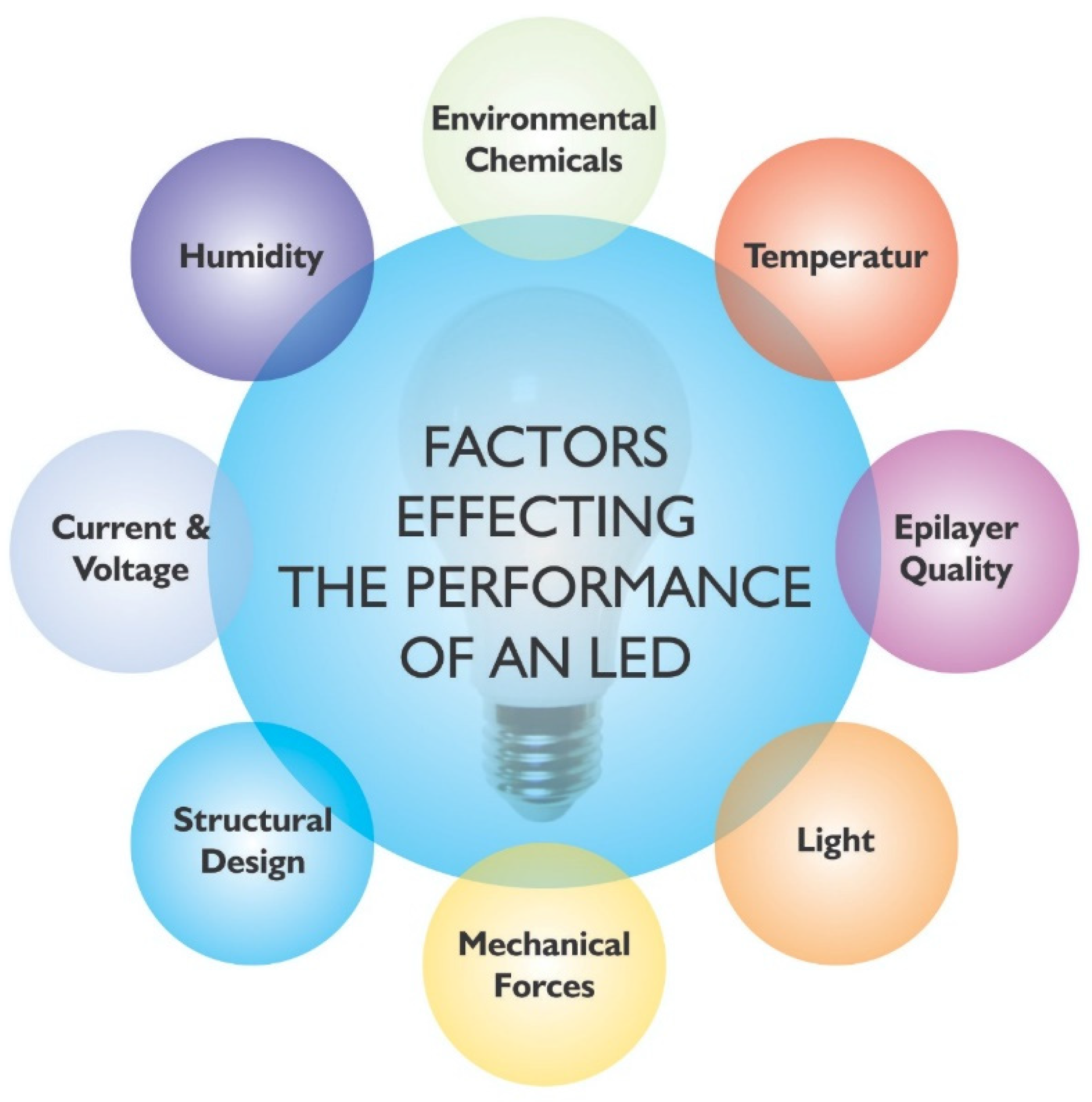
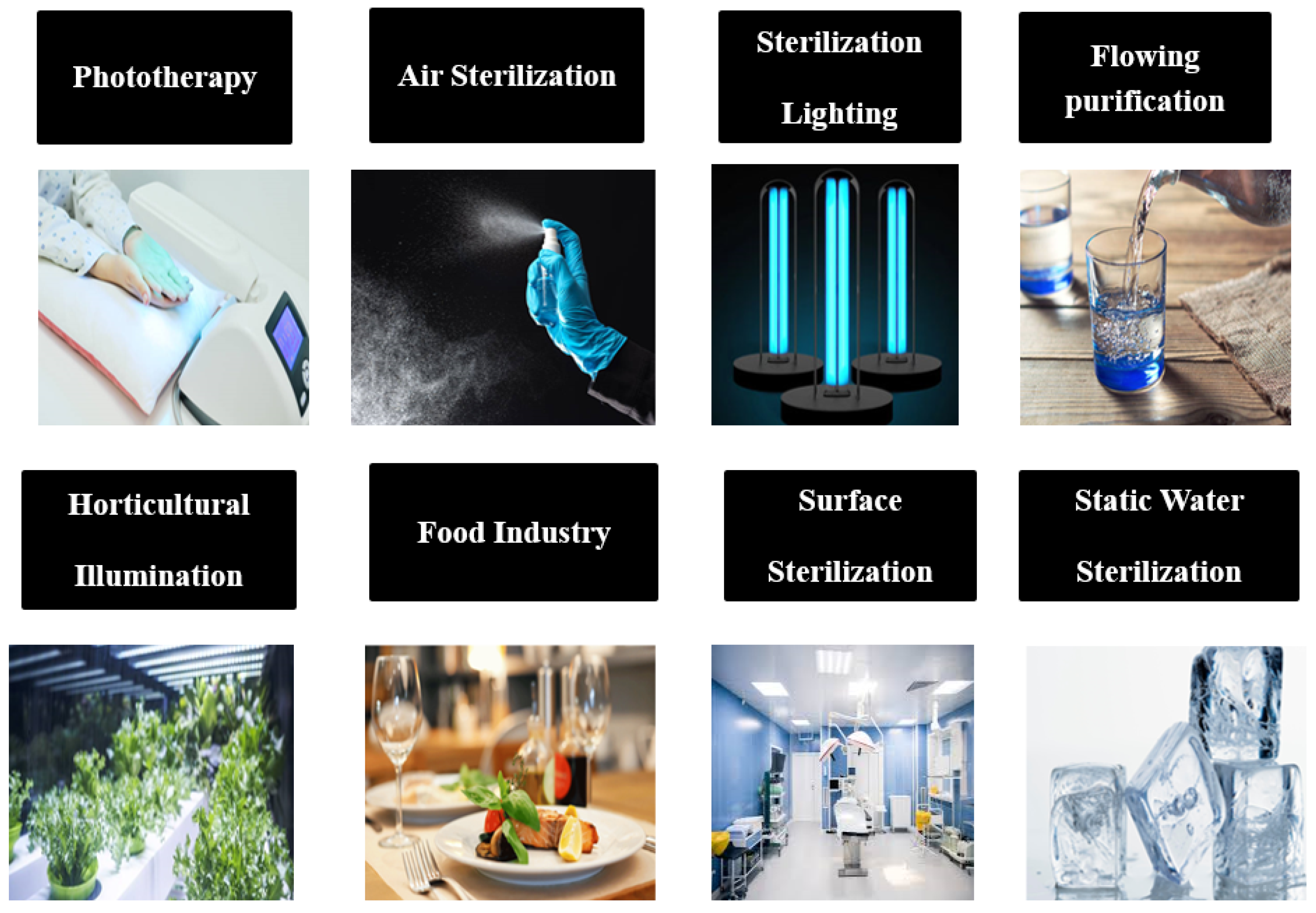


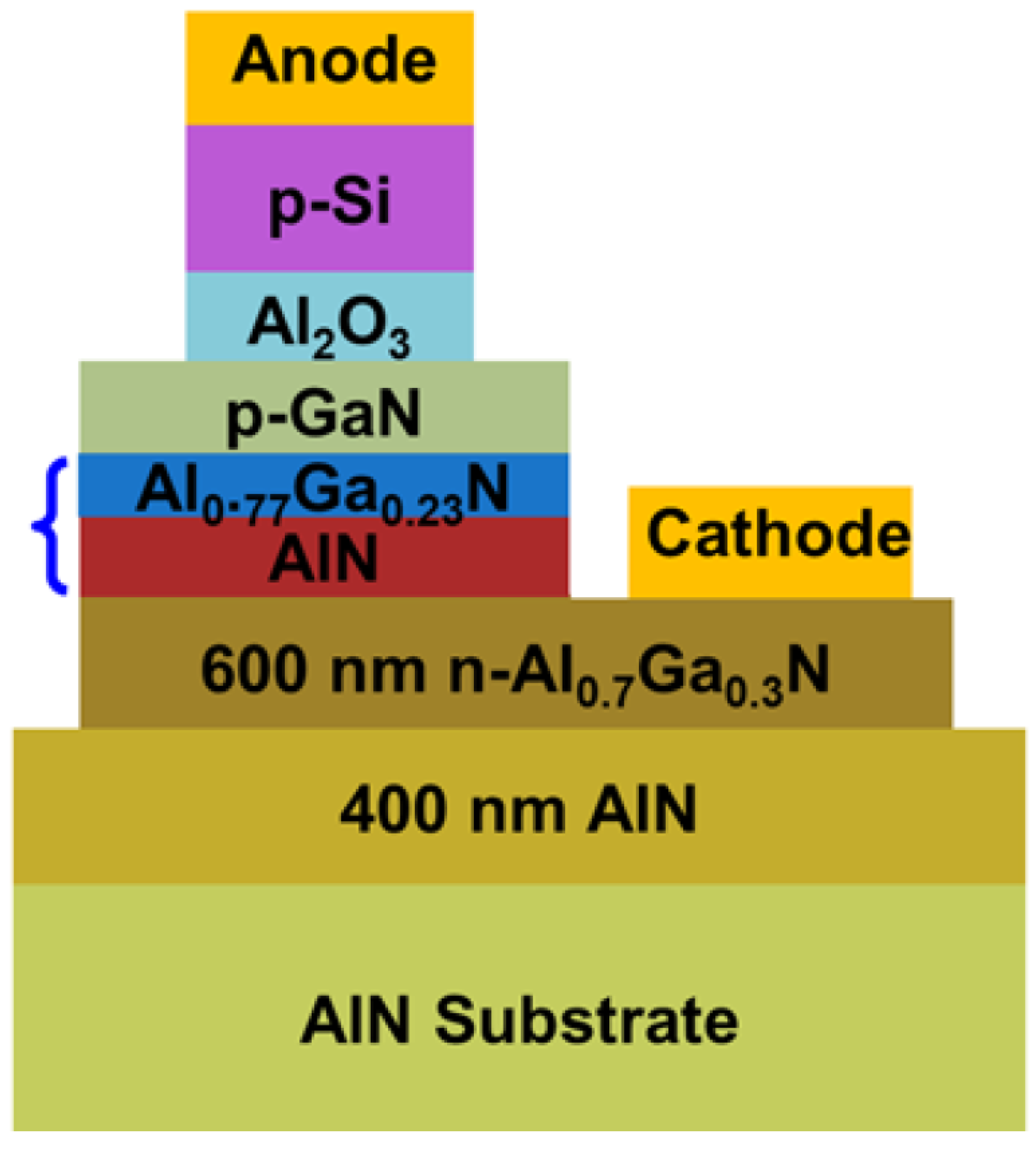

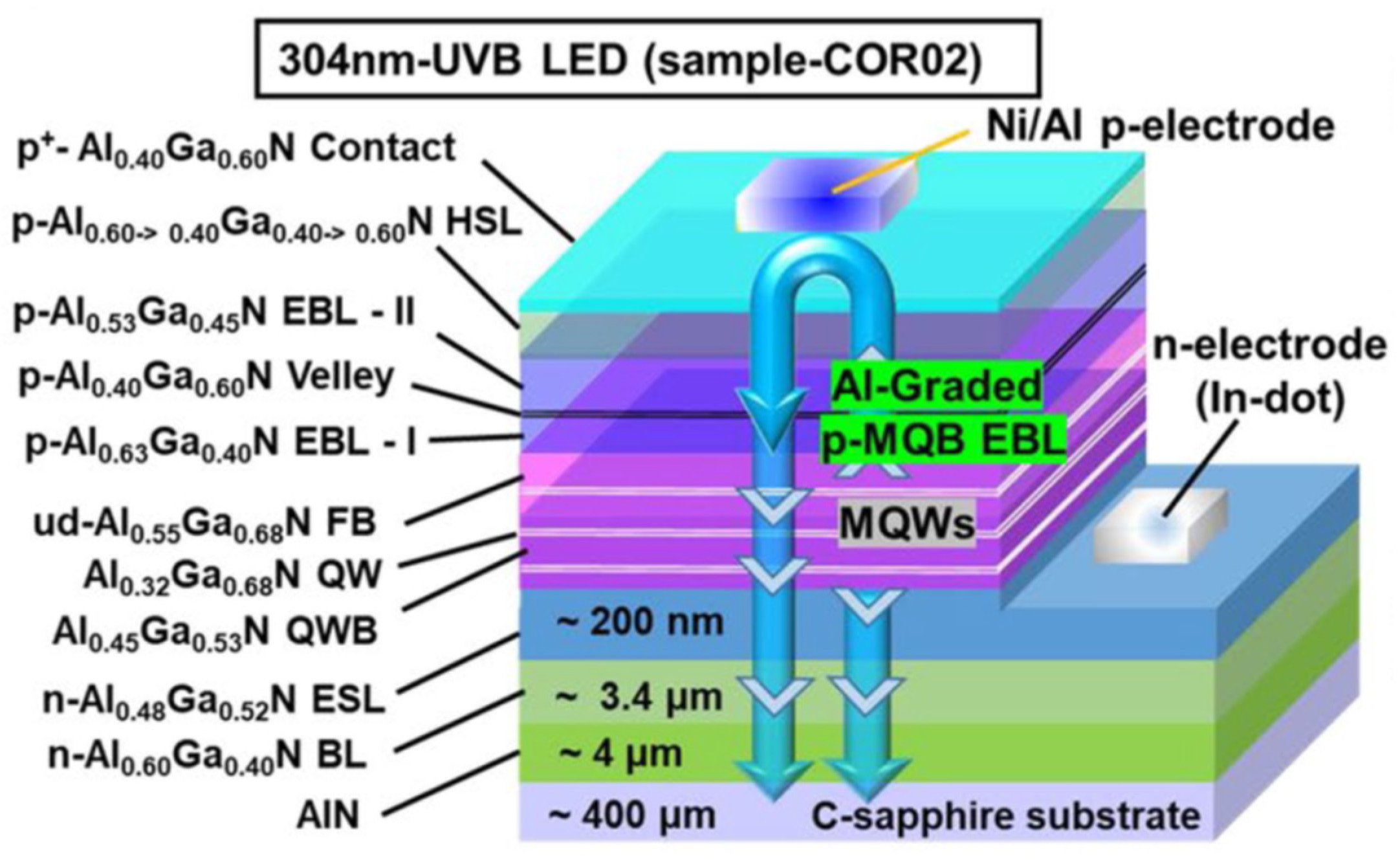
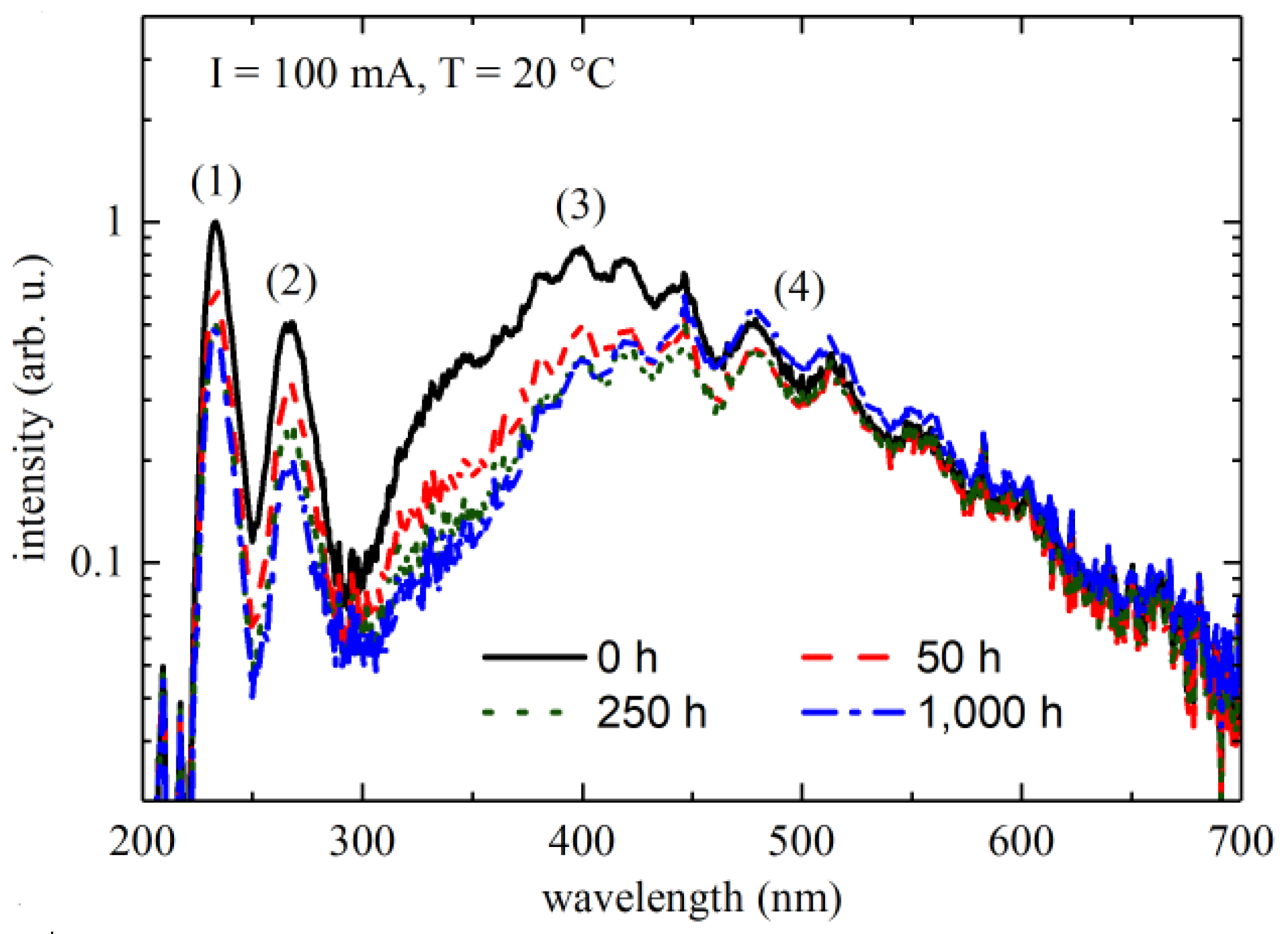




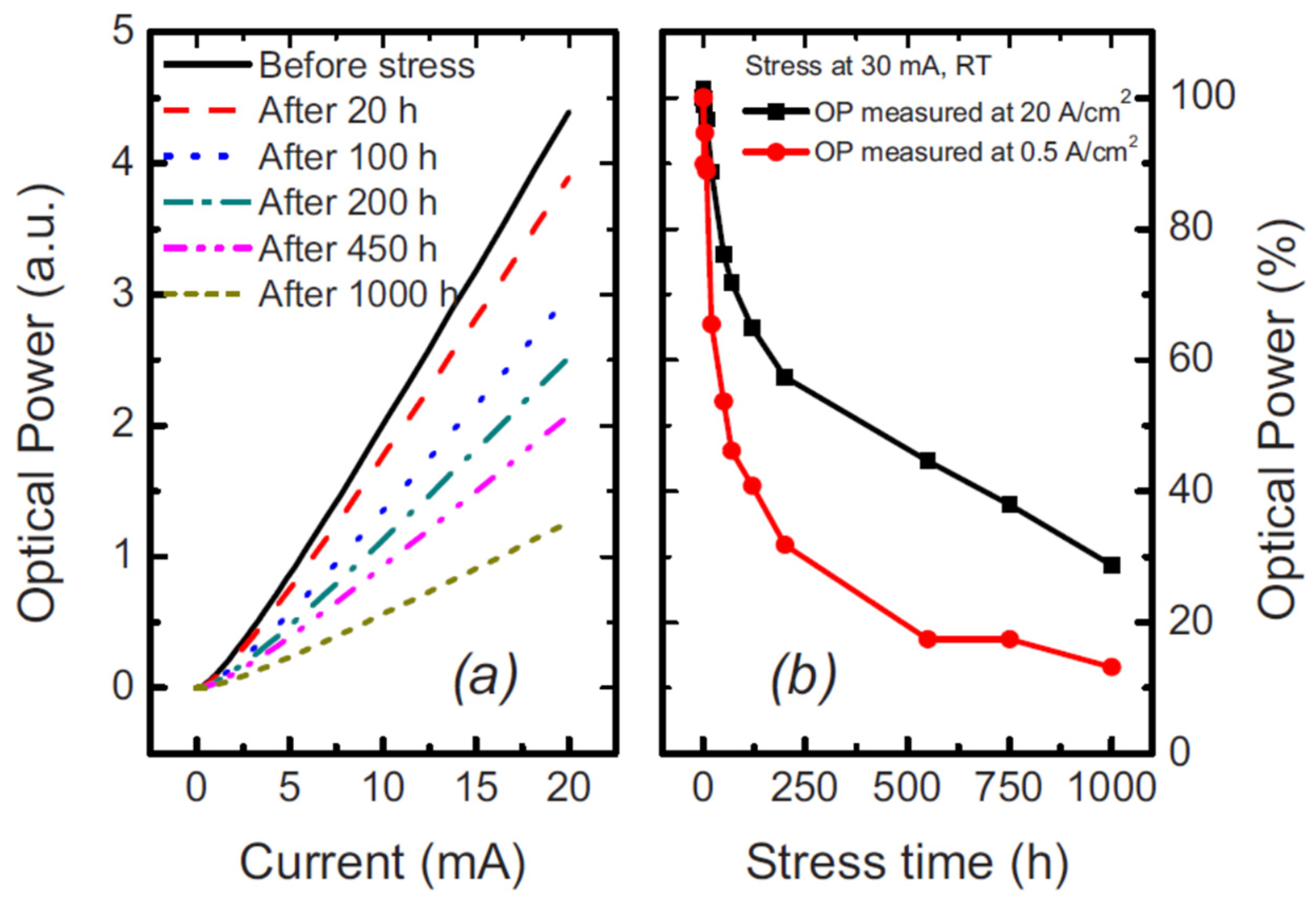
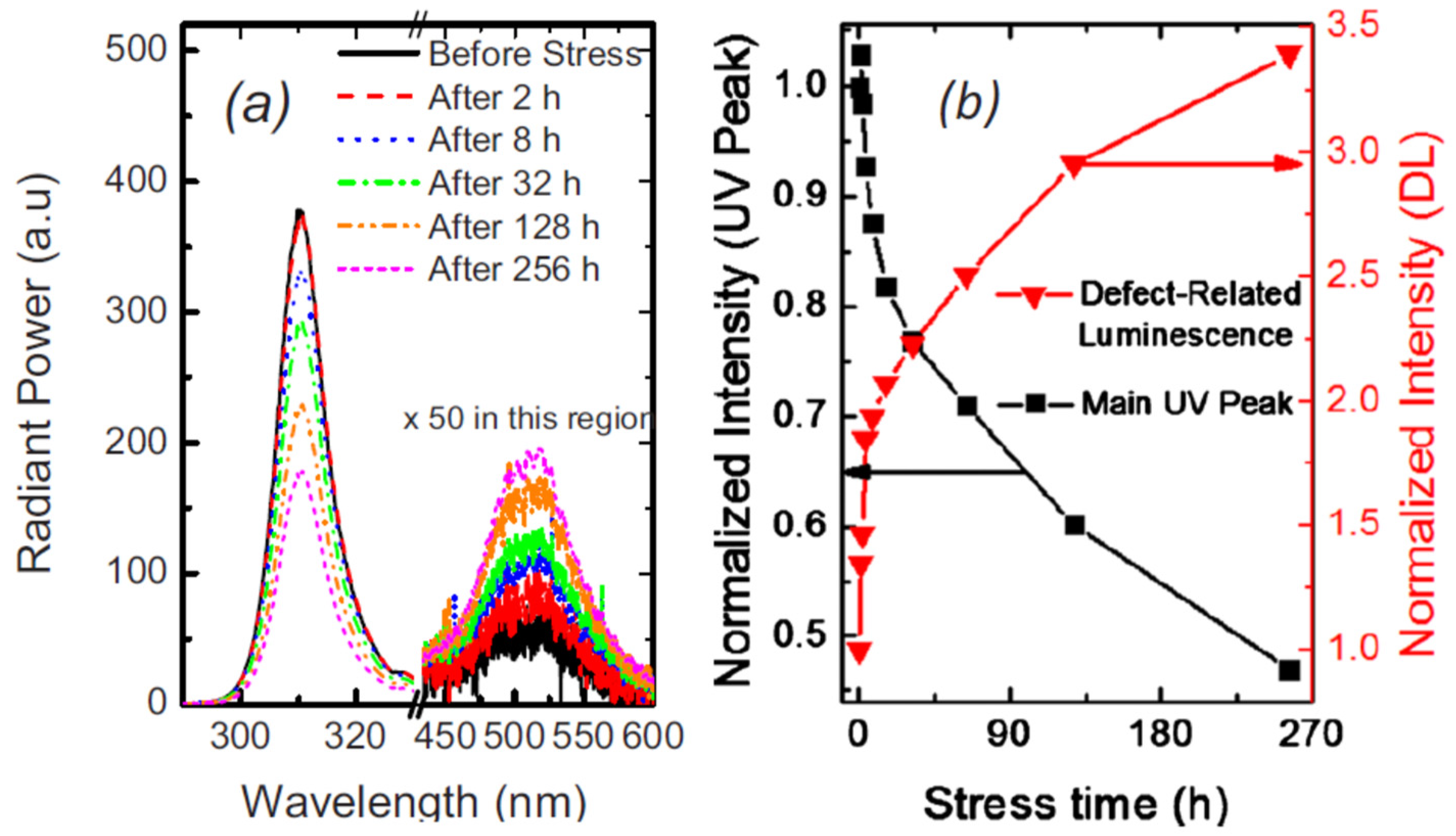
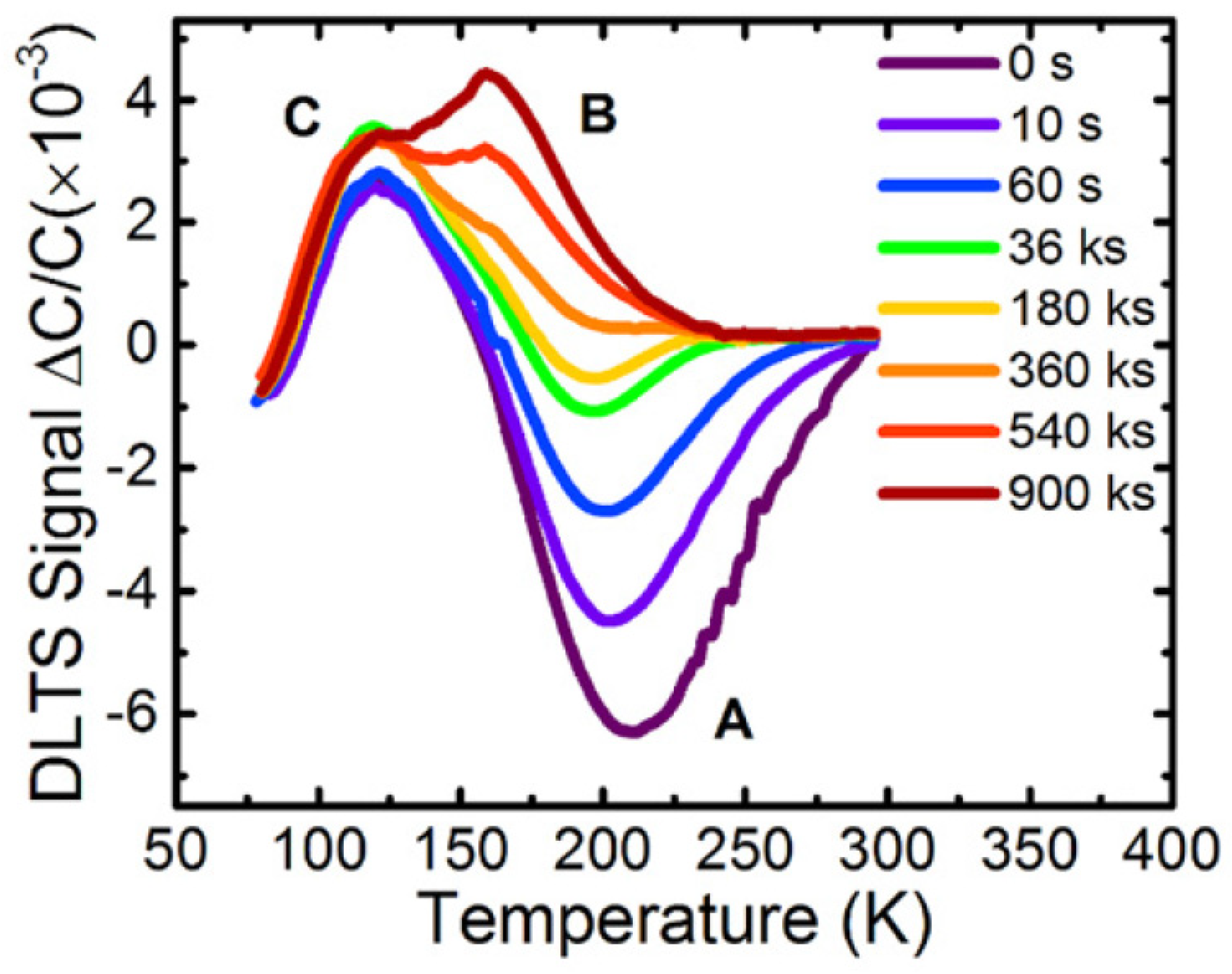
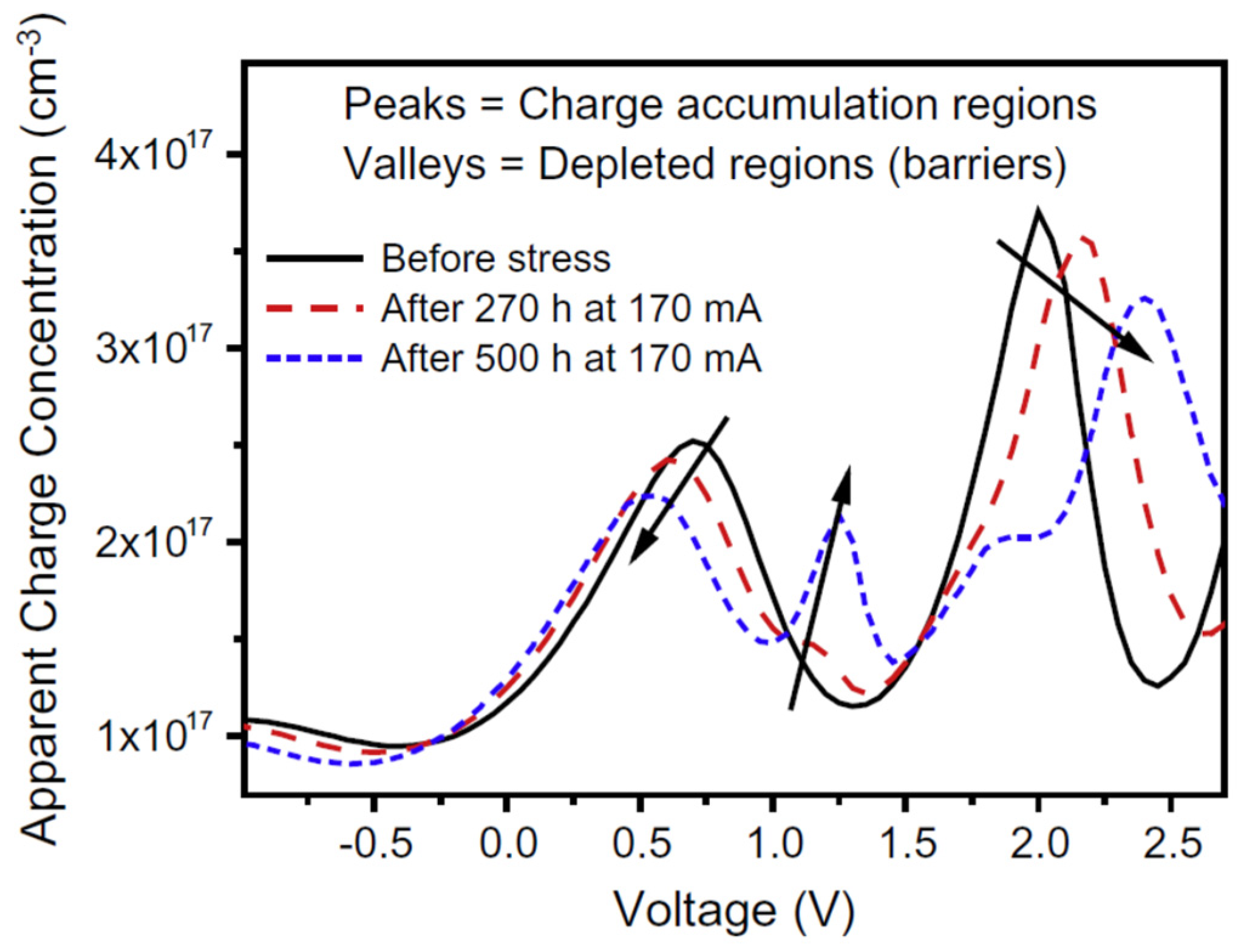
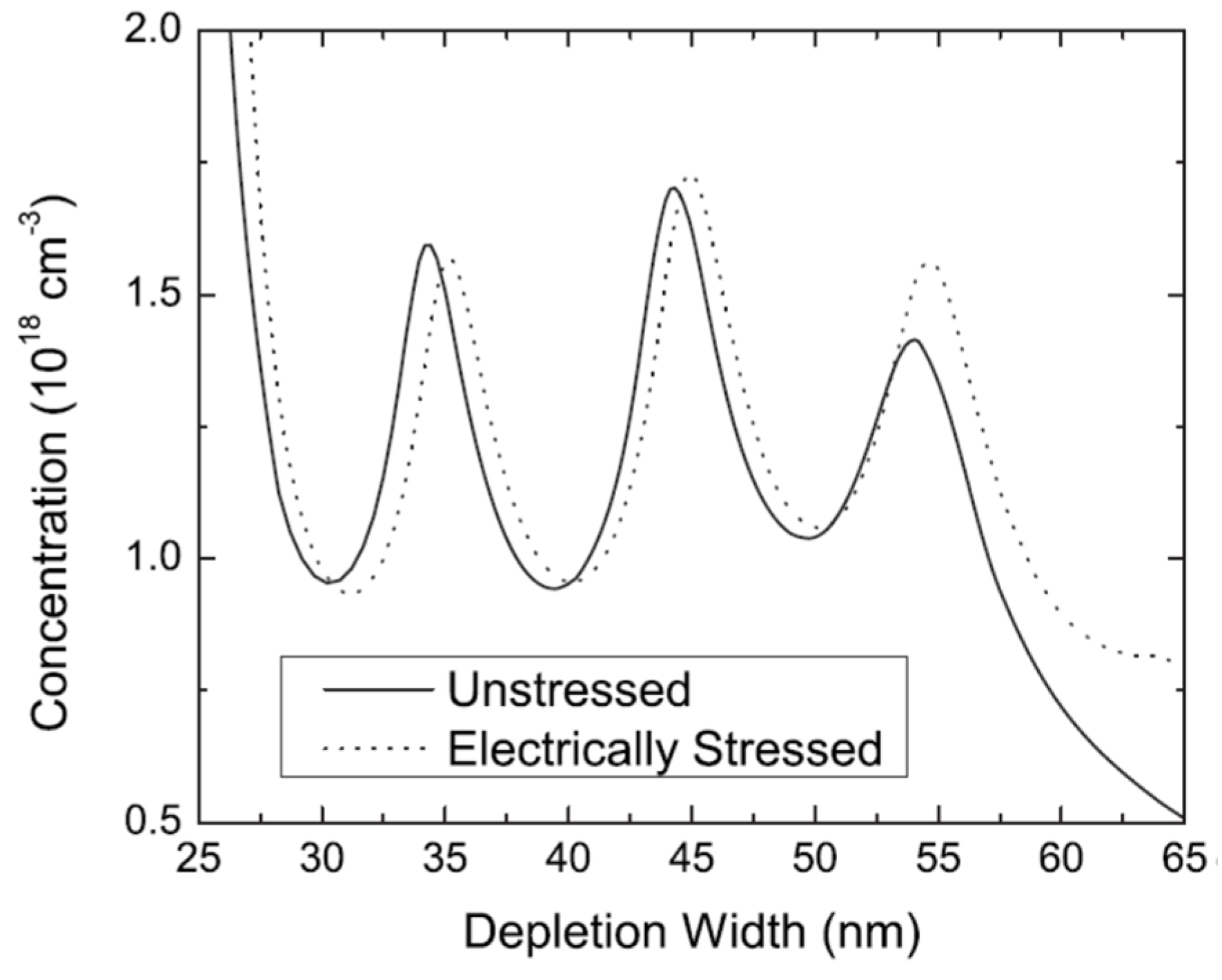

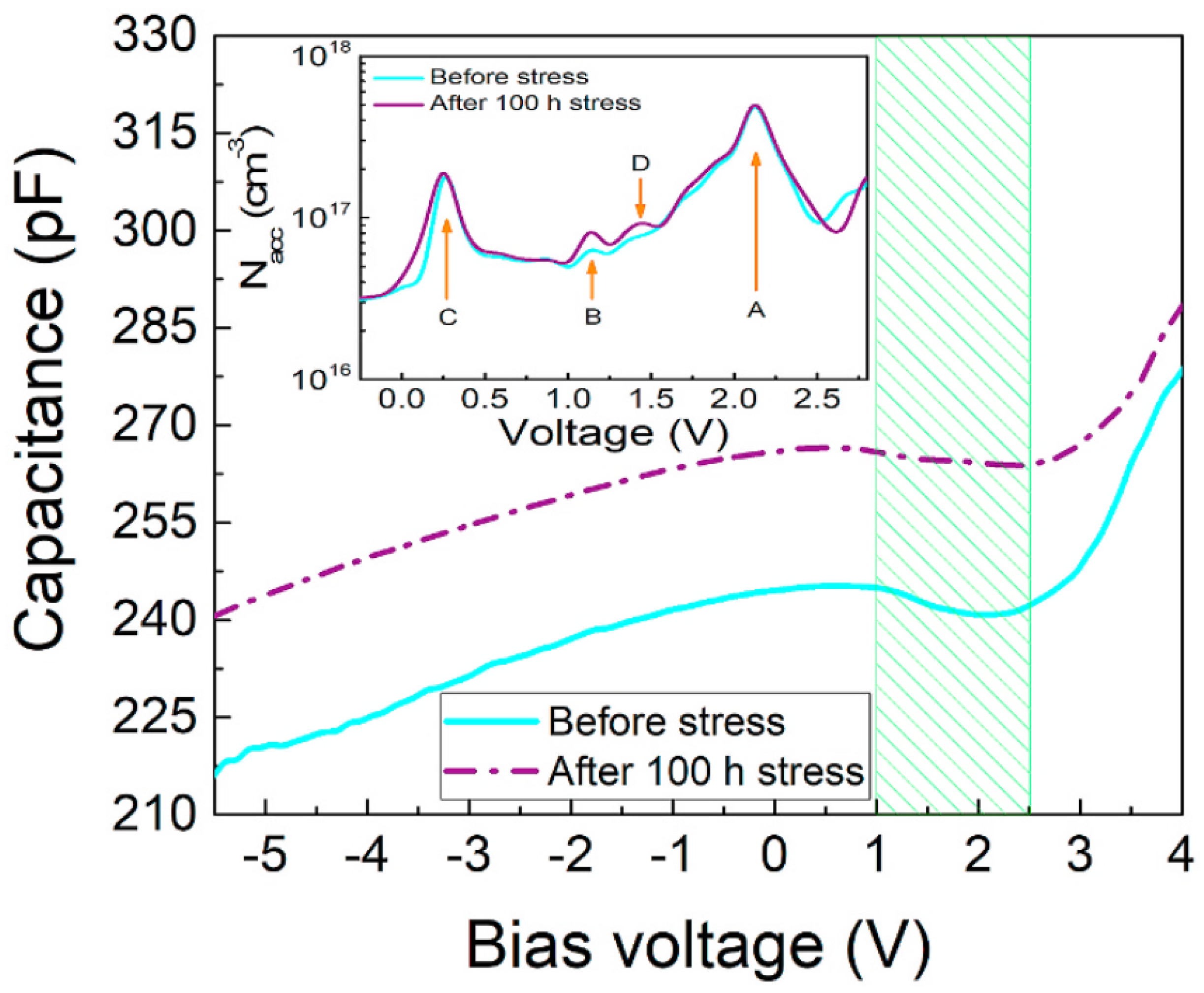
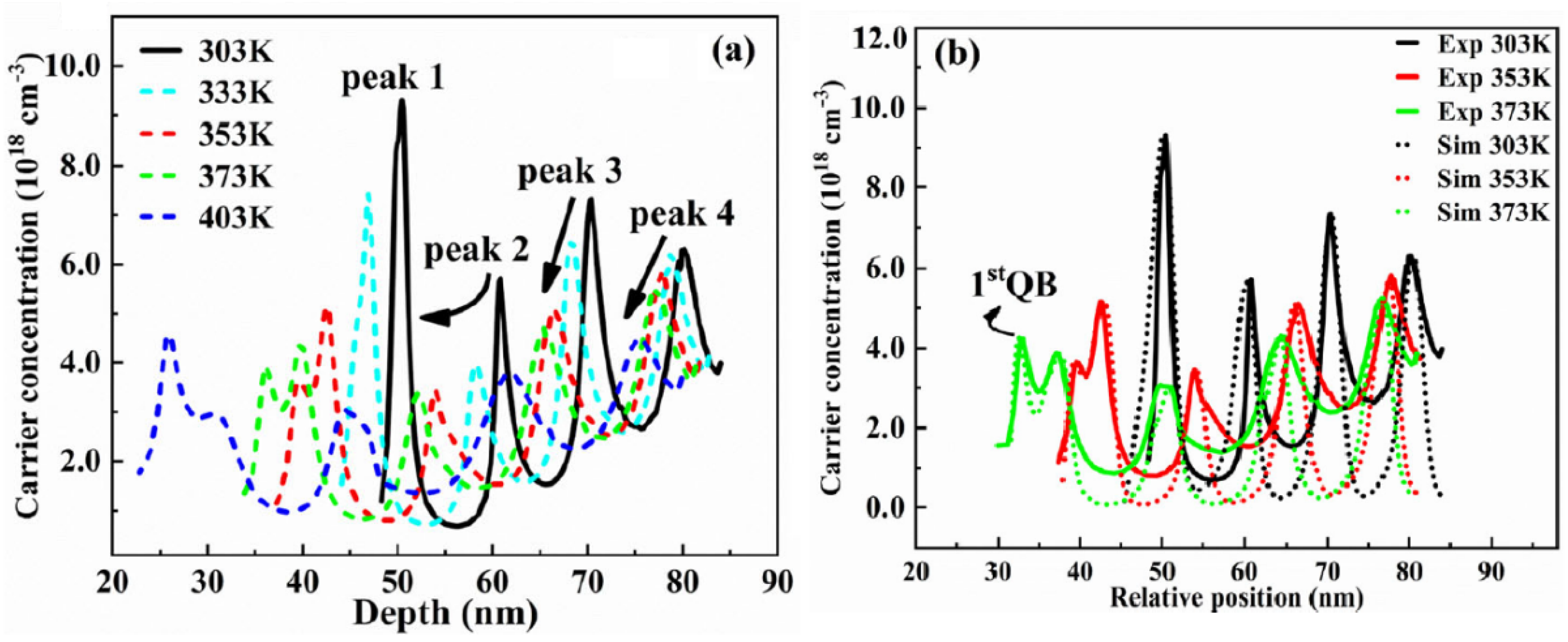

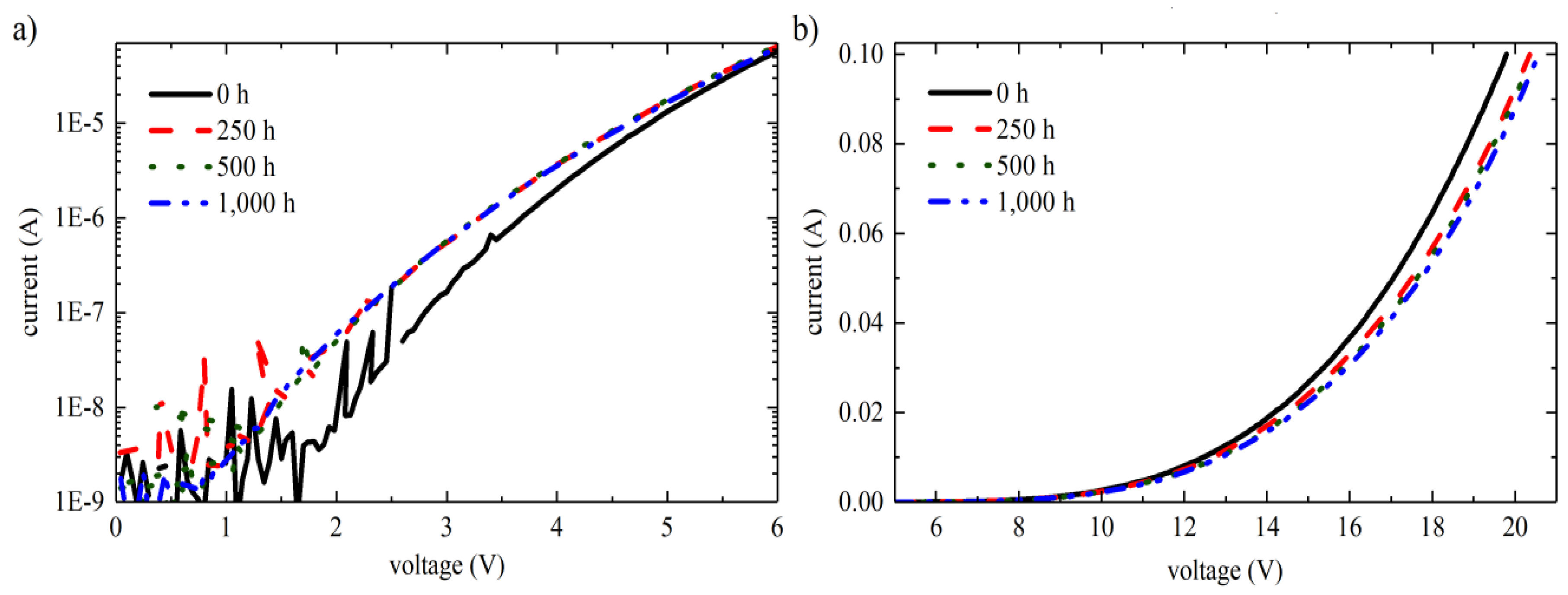
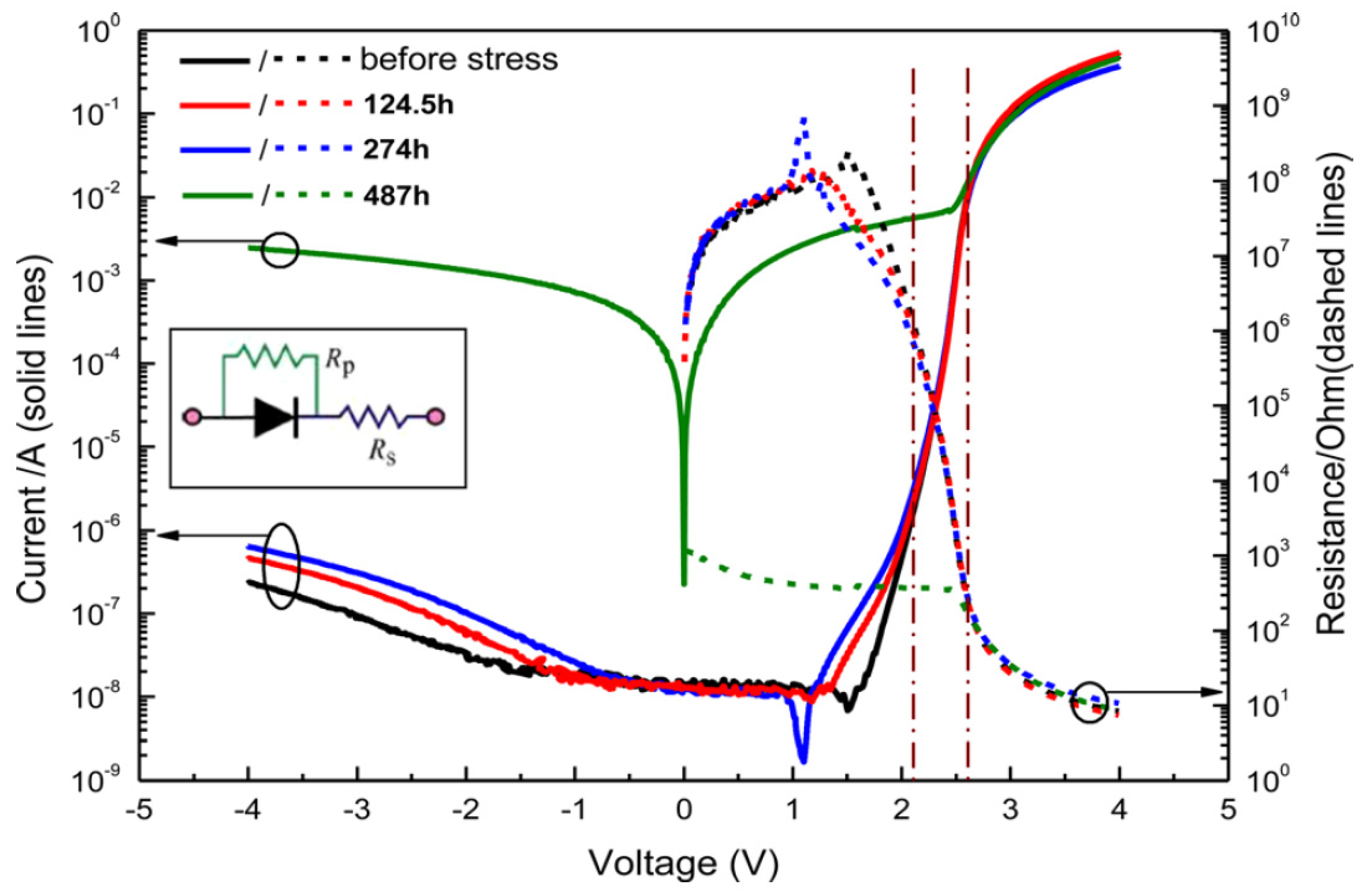
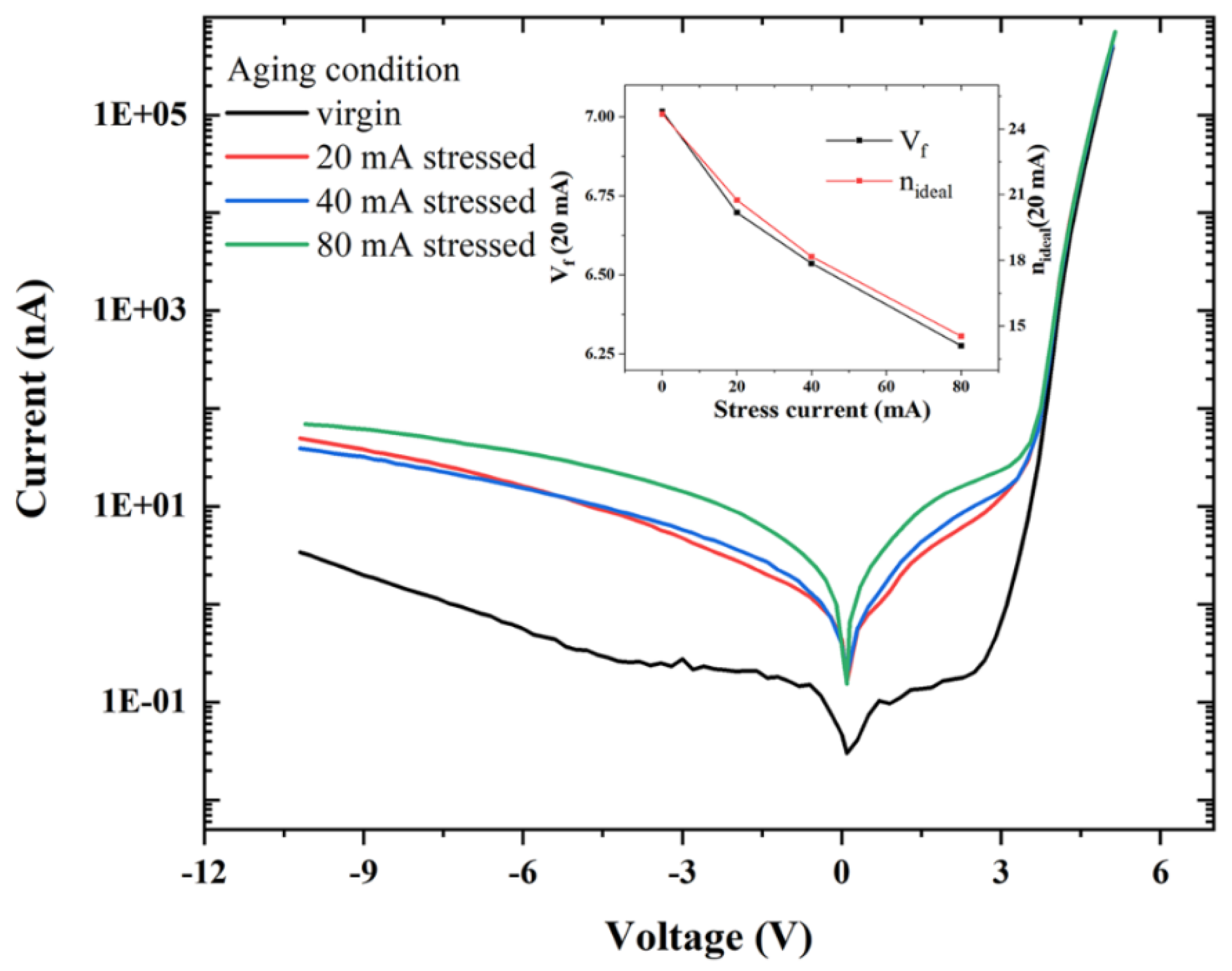
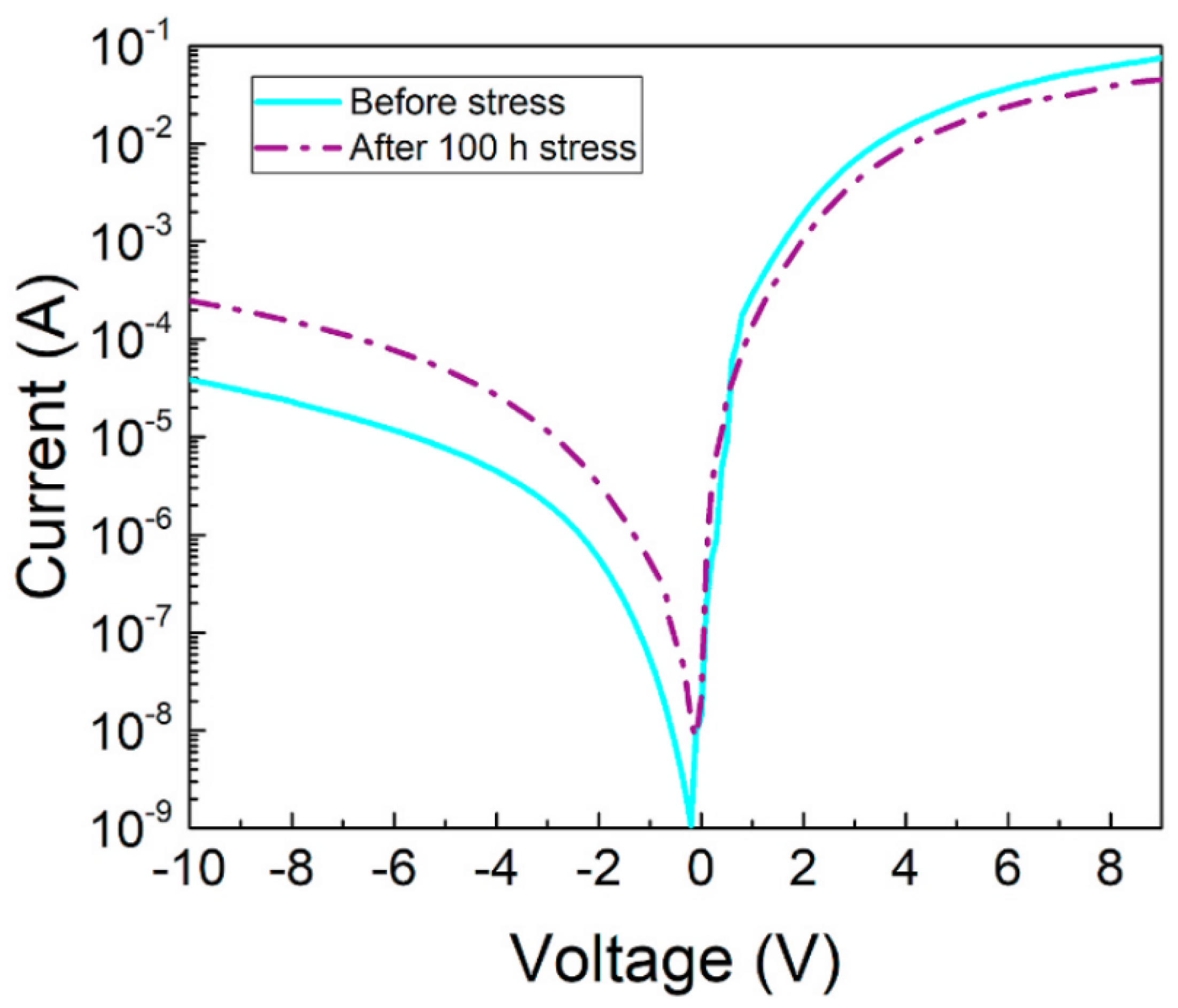
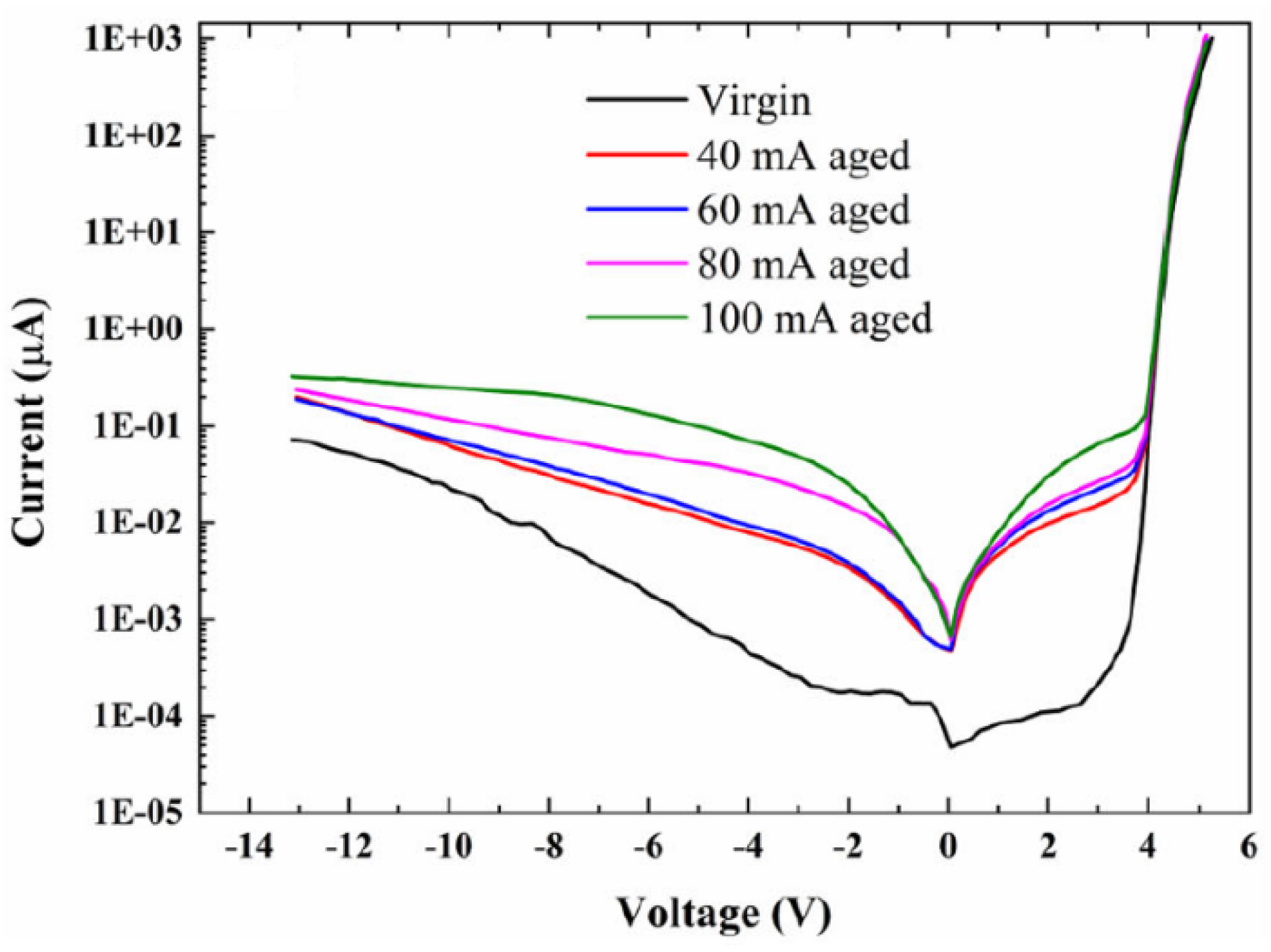
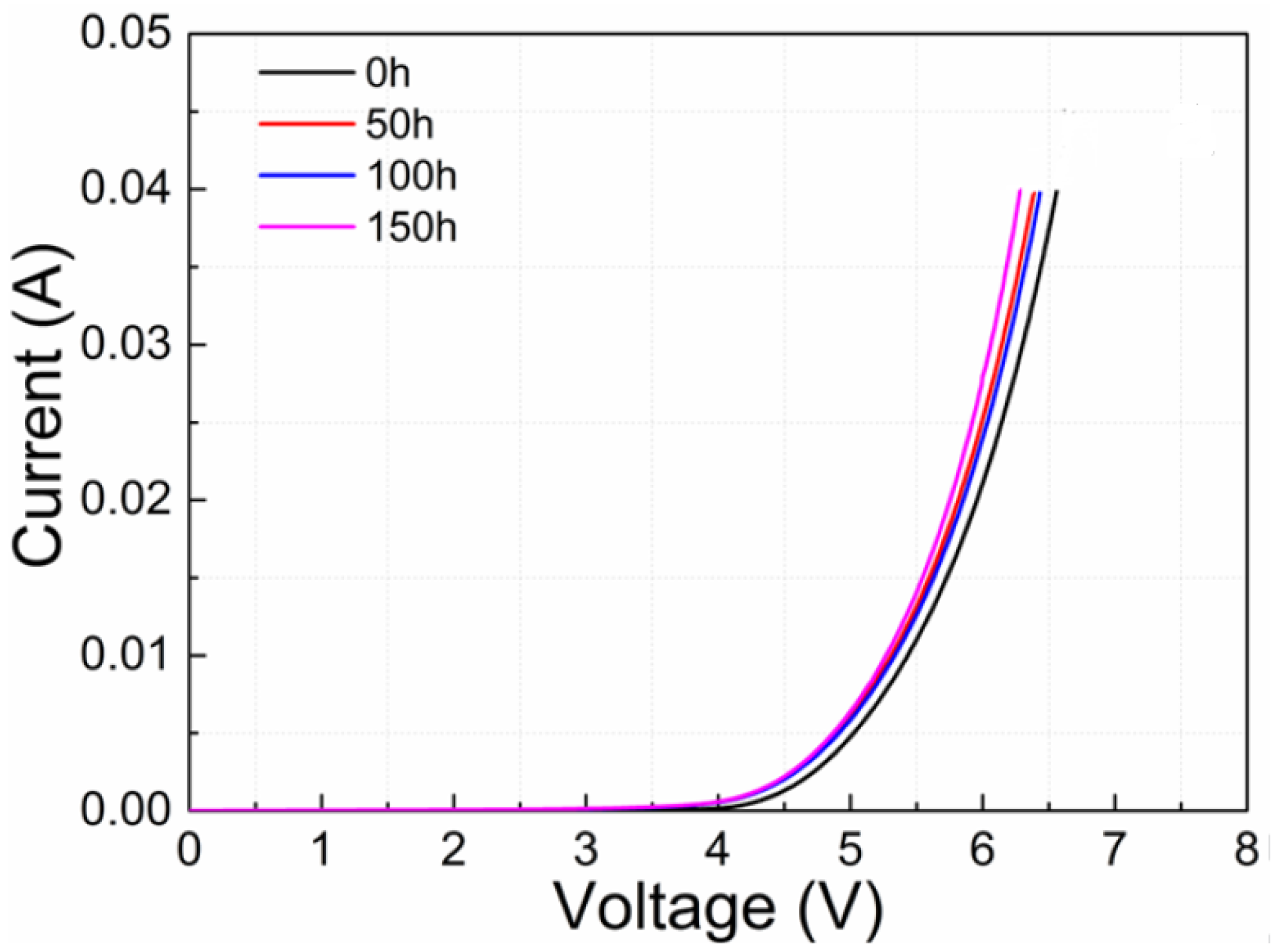
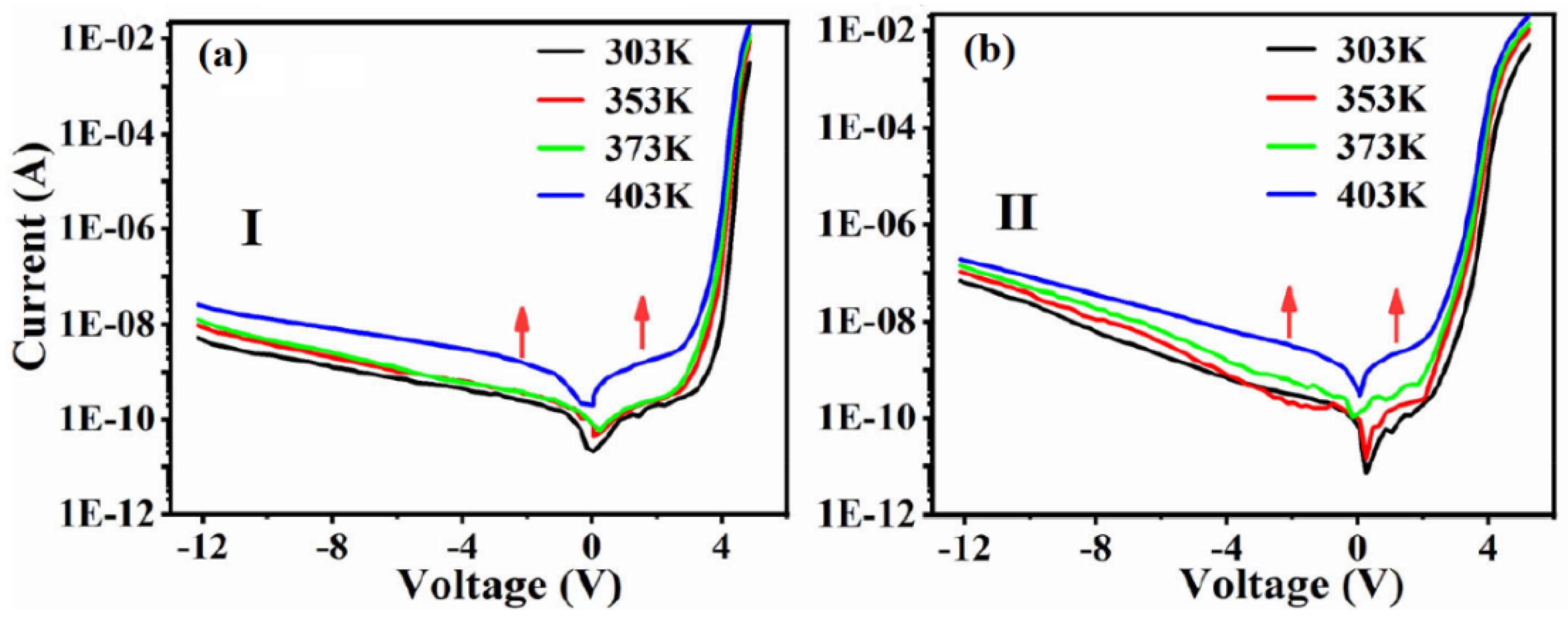
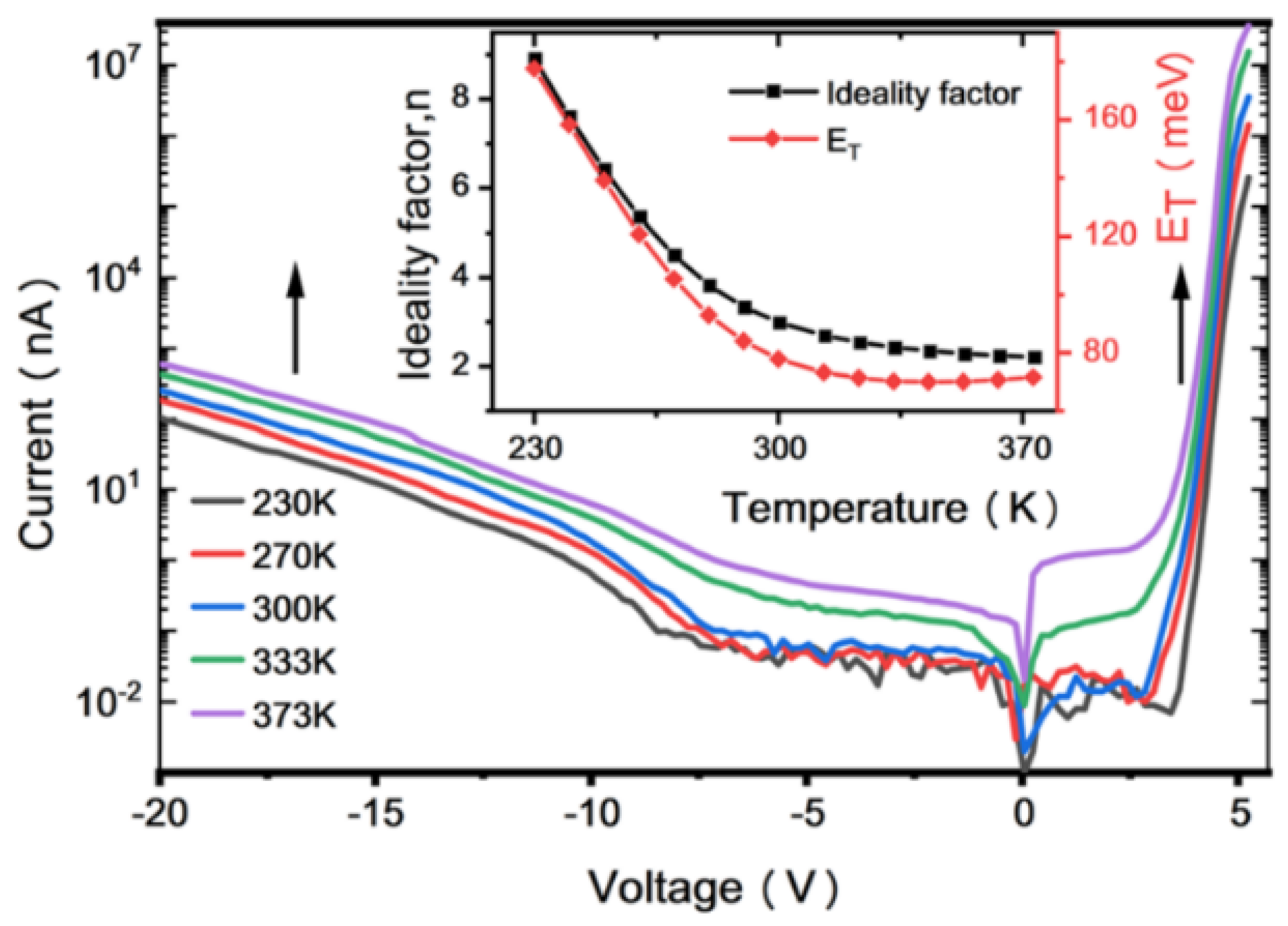
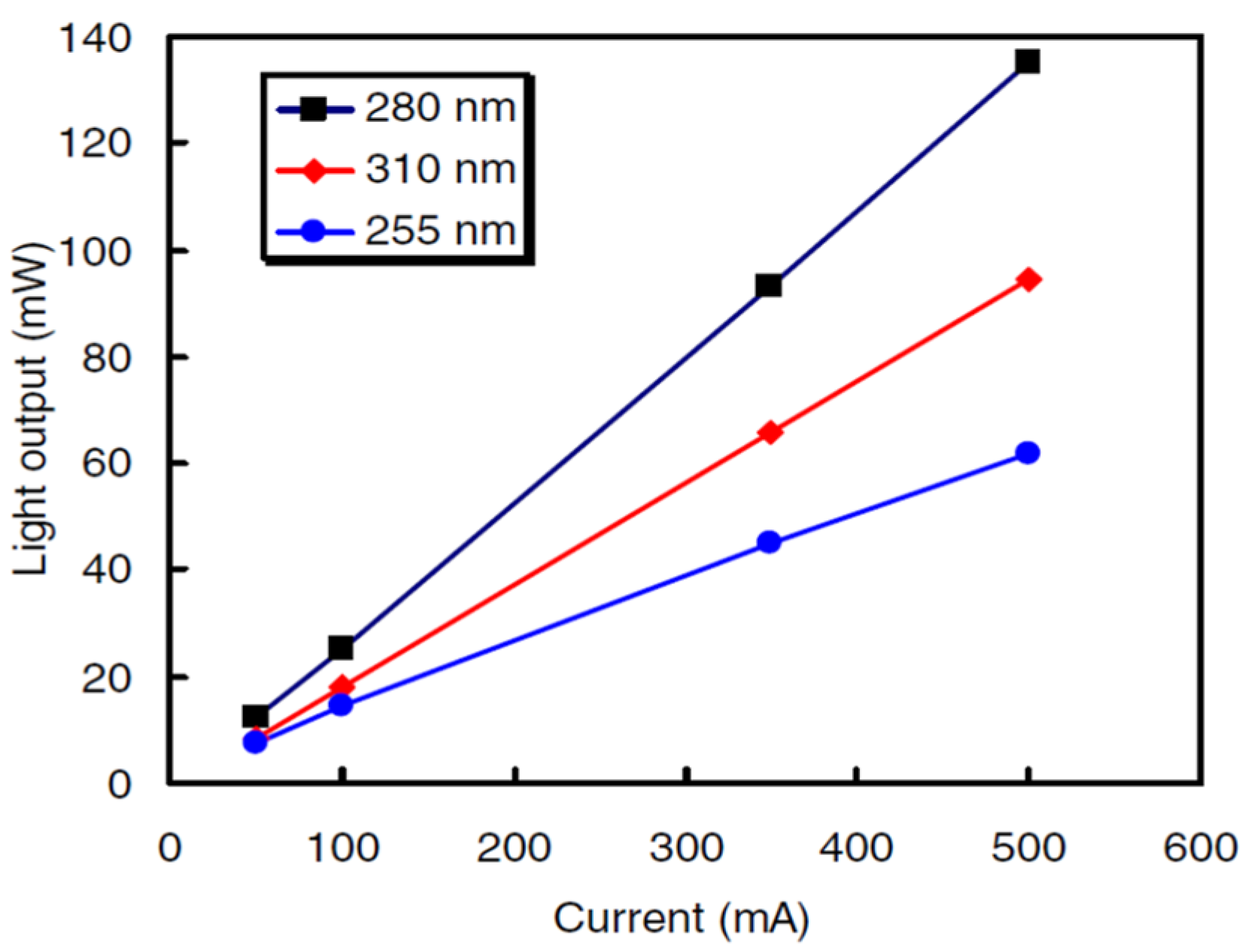
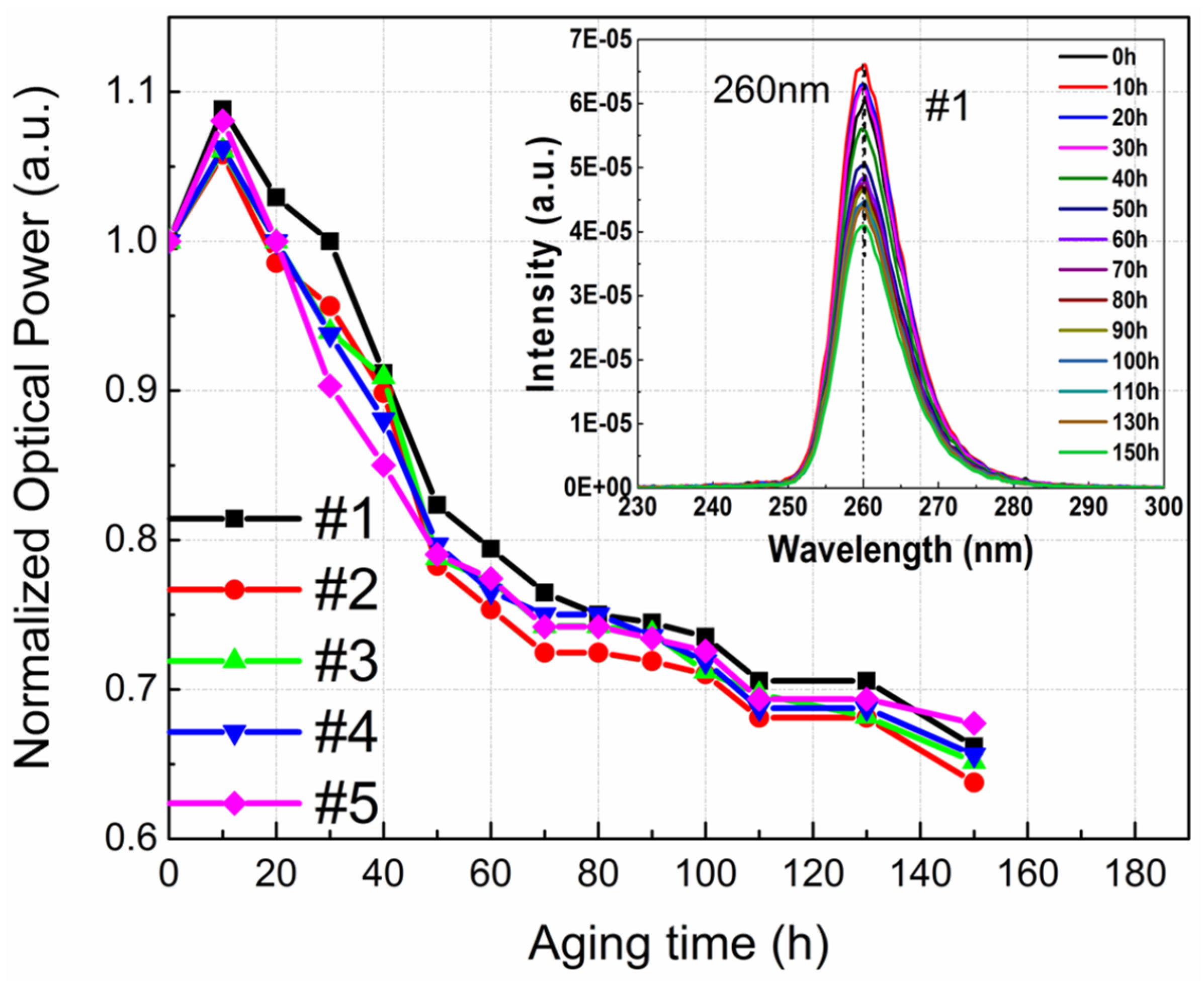

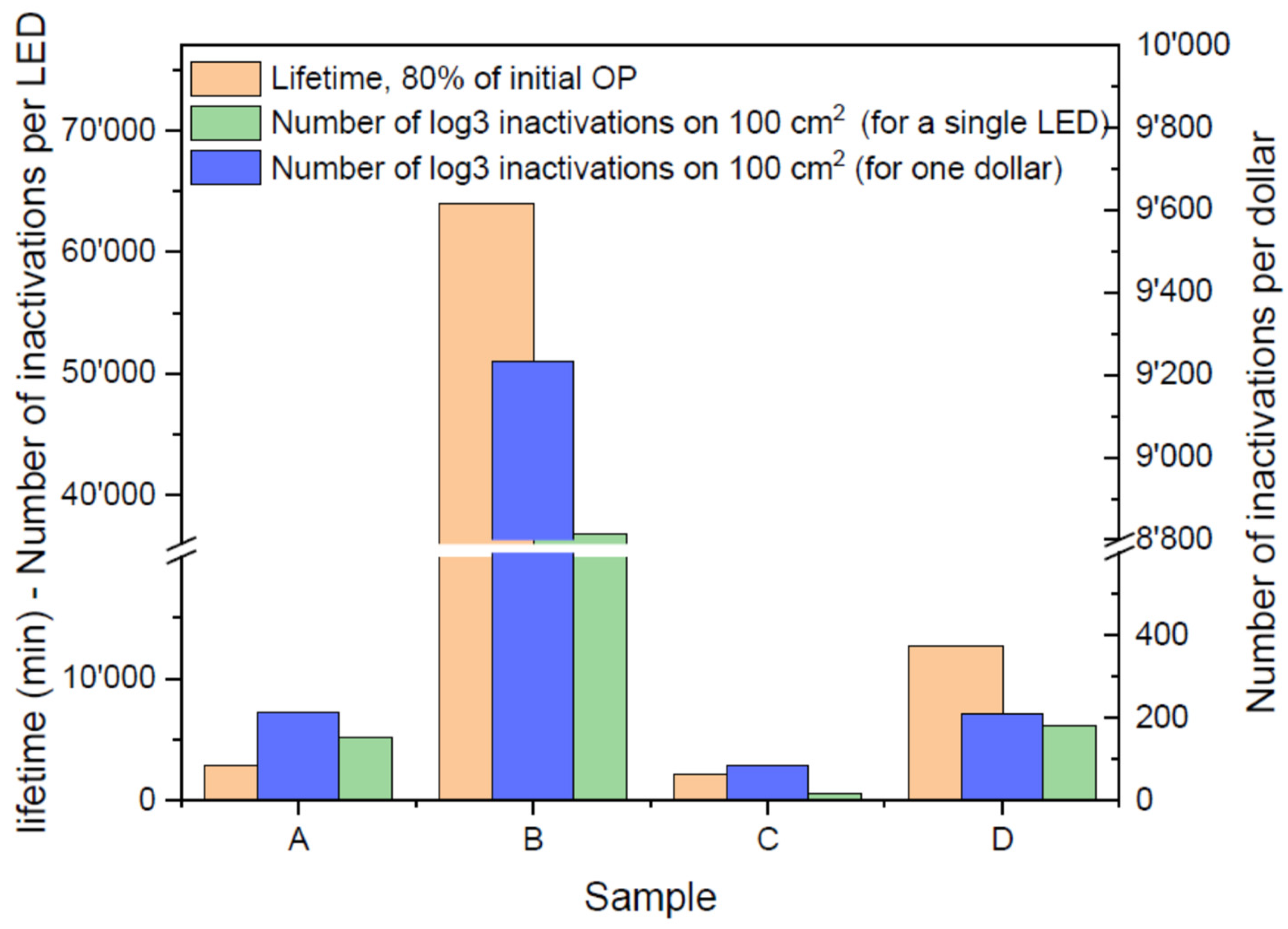
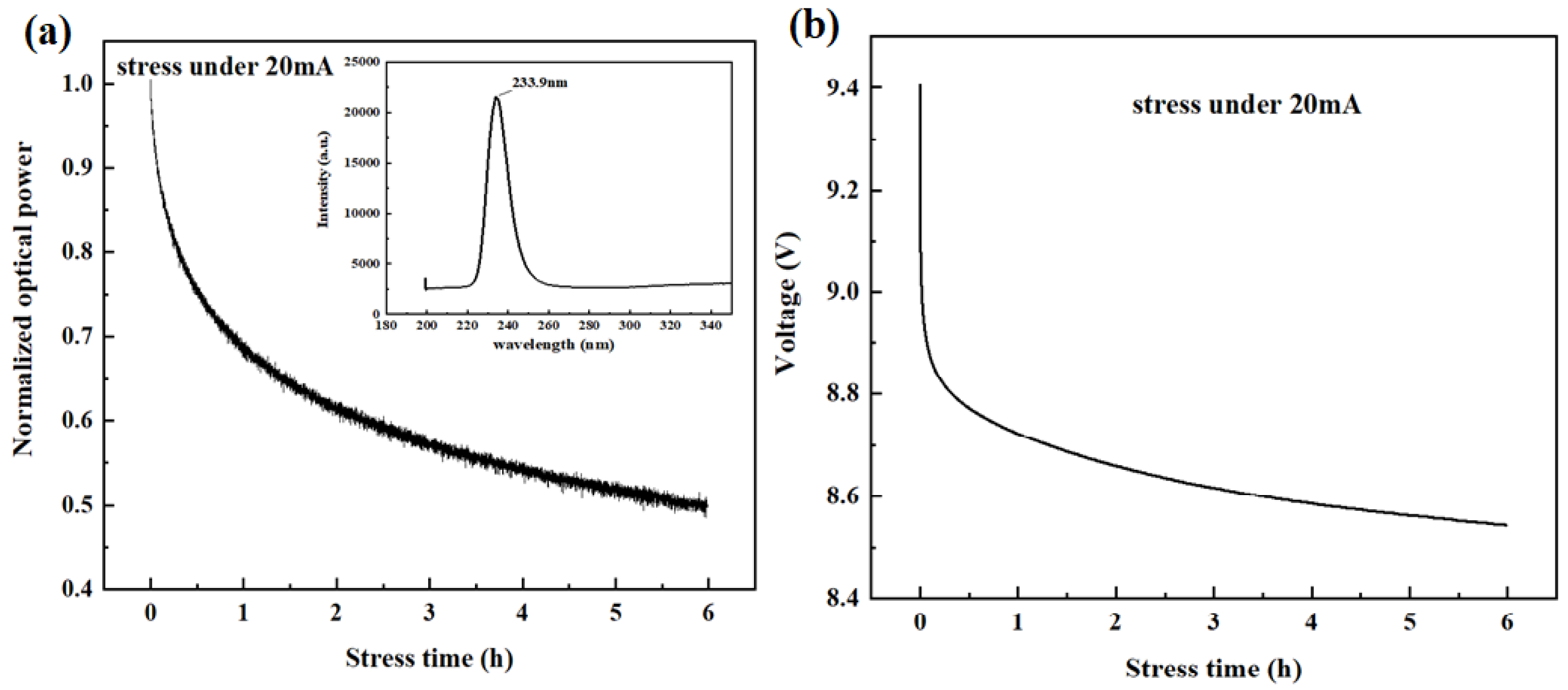
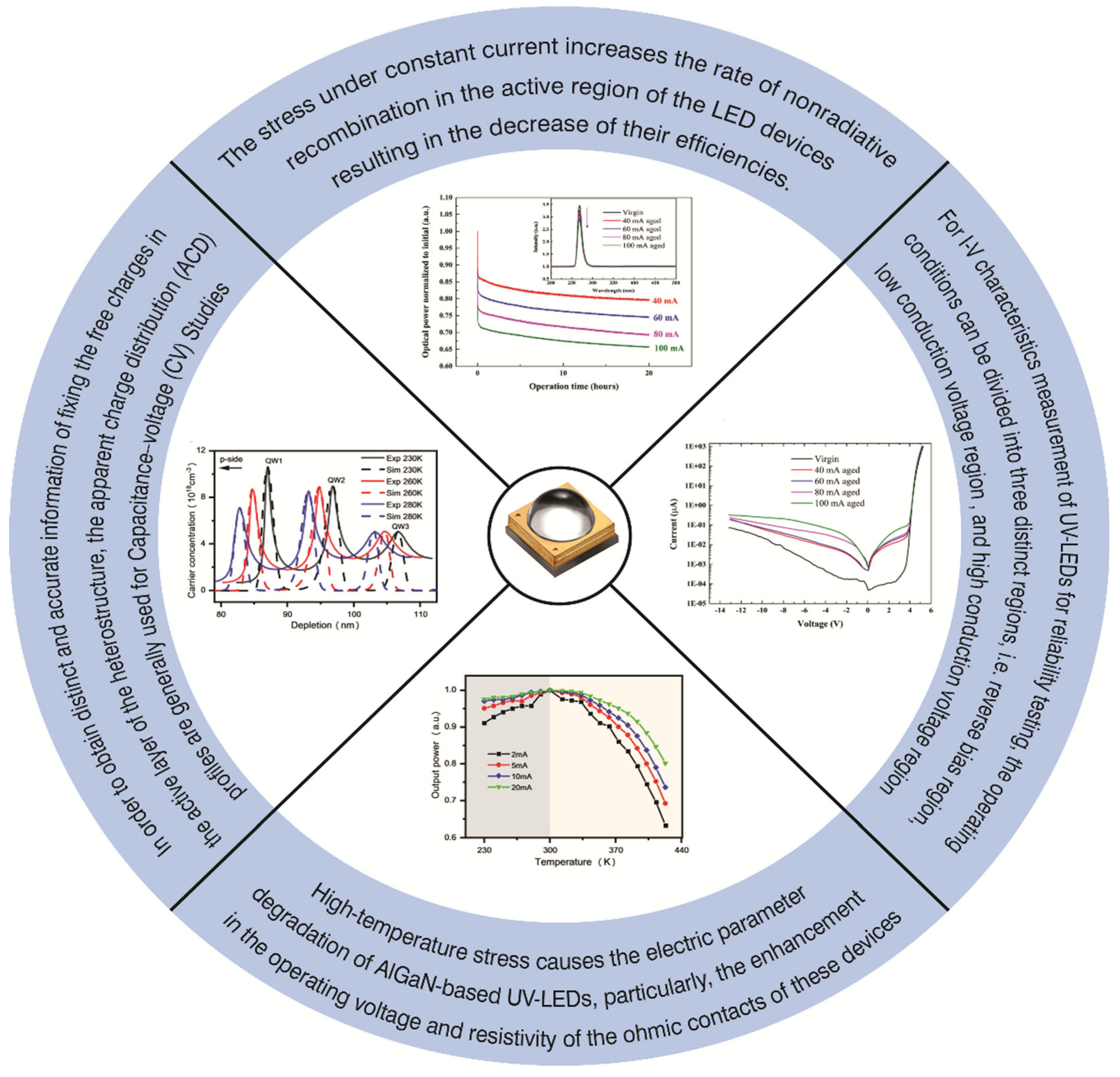
| Group | Technique | Substrate | EQE | Wavelength | Output Power | Year | Ref |
|---|---|---|---|---|---|---|---|
| Ajmal Khan et al. | graded stacks of AlGaN buffer layer | Sapphire | 4.4% | 310 nm 295 nm | 7.1 mW 13 mW | 2019 | [25] |
| Shucheng Ge et al. | nanoimprint lithography and top-down dry etching | Sapphire | 2.03% | 277 nm | - | 2019 | [26] |
| Ajmal khan et al. | highly reflective Ni/Al p-electrode and p-MQB EBL | Sapphire | 4.7%, | 310 nm | 29 mW | 2020 | [16] |
| Luca Sulmoni et al. | V/Al-based n-contacts with different Al mole fractions | AlN bulk substrate | 0.12% | 232 nm | 120 μW | 2020 | [27] |
| Tien-Yu Wang et al. | AlGaN and GaN sidewalls were turned into AlxGa2–xO3 and Ga2O3 sidewalls, respectively, by thermal oxidation | Sapphire | 0.76% | 280 nm | 0.69 mW | 2022 | [28] |
| Akira Yoshikawa et al. | improved n-metal electrodes | AlN single crystal substrates | - | 237 nm, 235 nm, 233 nm and 230 nm | 2.2 mW, 1.9 mW, 1.5 mW and 1.2 mW | 2019 | [29] |
| Yukio Kashima et al. | introducing a highly reflective photonic crystal into the surface of the p-AlGaN contact layer | Sapphire | 10% | 283 nm | >20 mW | 2018 | [20] |
| Dong Liu et al. | employing p-type Si | single crystal bulk aluminum nitride (AlN) | 0.03%. | 229 nm | 160 ηW | 2018 | [17] |
| Liang Lu et al. | developing composite last quantum barrier (CLQB) | Sapphire | - | 310 nm | Increased by 30% | 2021 | [30] |
| Ray-Hua Hrong et al. | Zinc gallate thin films as the p-type transparent contact layer | Sapphire | 5.5% | 280 nm | ~12 mW | 2017 | [31] |
| Chunshuang Chu et al. | polarization induced positive sheet charges at the last quantum barrier (LQB)/p-EBL interface. | - | 3.5% | 280 nm | ~20 mW | 2019 | [32] |
| Youn Joon Sung et. al | using a highly reflective ITO/Al p-type electrode. | - | 6.68% | 277.6 nm | 630 mW | 2019 | [33] |
| Su-Hui Lin et al. | Introducing a reflective passivation layer (RPL) consisting of HfO2/SiO2 stacks | Sapphire | 3.09% | 280 nm | 125.24 mW | 2021 | [18] |
| Michiko Kaneda et al. | fabricated on n-AlGaN templates | AlN templates on sapphire | 3.5, 3.9, 6.1, and 6.0% | 266, 271, 283, and 298 nm, | ~26 mW | 2017 | [34] |
| Takayoshi Takano et al. | a transparent AlGaN:Mg contact layer, a Rh mirror electrode, an AlN template on a patterned sapphire substrate, and encapsulation resin. | Sapphire | 20% | 275 nm | 44.2 mW | 2017 | [35] |
| Zi-Hui Zhang et al. | specifically designed superlattice p-type electron blocking layer (p-EBL). | Sapphire | ~3.4% | 270 nm | ~24 mW | 2018 | [21] |
| Research Group | Temperature | Required Time | Current | Voltage | Intensity/Voltage/Current | Reason(Degradation Cause) | Ref |
|---|---|---|---|---|---|---|---|
| A. Pinos et al. | 600–1000 K | 86 h | 100 mA | (~3.5 V) | increase tunneling current, decrease emission intensity | formation of tunneling conductivity channels | [50] |
| Matteo Meneghini et al. | 180–250 °C | (100–1000 h) | 20 mA | −5 V to 3 V | current decreasesvoltage increases | increase of nonradiative recombination paths | [39] |
| Matteo Meneghini, et al. | >80–100 °C | 2000 h | 1 A | 2 to −2 V | current increasesvoltage decreases | Degradation rate increase with increasing junction temperature level. | [3] |
| Matteo Meneghini et al. | 35–85 °C | 1200 h | 20 mA | 4 V to 6 V | current decreases | generation/propagation of defects in the active region of the devices | [40] |
| Craig G. Moe et al. | 57 °C and 184 °C | 64 h | 20 and 75 mA | current decreases | Increased nitrogen vacancy formation | [46] | |
| Johannes Glaab et al. | 20 °C | 1000 h | 100 mA | 19.9 V | current decreasesvoltage increases | Nonradiative recombination centers occurrence in or around the active region. | [36] |
| Huixin Xiu et al. | 135 °C | 50 h | 20 mA | 6.367 V | intensity decreasestunneling current increases | decrease of the leakage current | [47] |
| N. Trivellin et al. | 15 °C to 85 °C. | 2000 min | 350 and 500 mA | 6.5 V | current increasesvoltage decreases | new emission peak arose | [48] |
| Lilin Liu, et al. | 25 °C | 1000 h | 600 mA | −3 V to 3 V | tunneling current increases | damaging the active layers and improving the p-type conductivity | [57] |
| Jan Ruschel et al. | 25 °C | 1000 h | 50 to 300 mA | 9 V | current increases | Degradation rate independent of the current density. | [51] |
| Literature Survey | Frequency Range | Required Time | Voltage Range | Capacitance/ Voltage/ Current | Reason (Degradation Cause) | Ref |
|---|---|---|---|---|---|---|
| Matteo Meneghini et al. | 270–500 h | 5.4 V | voltage increases | Increase in the defectiveness of the active layer of the LEDs. | [25] | |
| Matteo Meneghini et al. | 20–1000 h | 2.5 V | current decreases | Increase in defect-related radiative recombination components. | [32] | |
| Craig G. Moe et al. | 1 MHz | 0–64 h | current decreases | wider depletion region which extends further into the p-layer after electrical degradation | [17] | |
| Our Group results | 200 Hz–2 MHz | 0.5 h | capacitance increases | Increase in the trap centers | [43] | |
| Matteo Meneghini et al. | 250 h | (−8–0) V | current decreases | Increase of the nonradiative recombination rate. | [51] | |
| Our Group results | 1 MHz | (0–5) V | capacitance increases | Increase of nonradiative paths. | [42] | |
| Pradip Dalapati et al. | 100 h | 1.46 V | capacitance increases | narrowing of depletion width | [45] | |
| Zhanhong Ma et al. | 1 MHz | 400 min | −20 V to 5 V | capacitance decreases | decrease of the effective carrier concentration, because of the increased defect during the operation | [48] |
| Literature Survey | Required Time | Current Range | Voltage Range | Voltage/ Current | Reason (Degradation Cause) | Ref |
|---|---|---|---|---|---|---|
| Johannes Glaab et al. | 1000 h | 100 mA | 19.9 V to 20.6 V | voltage increases | nonlinearity in the I-V characteristic | [36] |
| Lilin Liu et al. | 124.5 h 274 h 487 h | 20 mA | −6 V to 6 V | current increases | Shows ohmic behavior. | [57] |
| Matteo Meneghini et al. | 2–1064 h | 20 mA | −8 V to 4 V | current increases | good stability of ohmic contact and resistivity of neutral regions over stress time | [40] |
| Our Group results | 24 h | 80 mA | 1–2 V | current increases | activation of open-core dislocation in the active region | [73] |
| Pradip Dalapati et al. | 100 h | 60 mA | −5 to −10 V | current decreases | improvement in the net charge concentration | [75] |
| Our Group | 40–100 mA | −12 V to 6 V | current increases | defect-assisted tunneling process | [72] | |
| Zhanhong Ma et al. | 400 min | −10 V to 2 V | voltage decreases | defects increase within the active region | [78] | |
| Desiree Monti et al. | 1–1000 h | ≤2 nA | 0 to ∼4 V | current increases | generation of mid-gap states | [58] |
| F. Piva et al. | (t < 1000 min) (t > 1000 min) | 250 mA 350 mA | (V < 4.5 V), 1 V < V < 3 V | current increases | increase in the density of defects in the active region | [67] |
| Desiree Monti et al. | 20–50 h | 250 mA | 0 V to ~4 V | current increases | increase in the carrier generation components | [66] |
| Zhanhong Ma et al. | 0–150 h | 0.05 A | 0 to 4.5 V | current increases | forming parasitic current paths across the active region | [81] |
Publisher’s Note: MDPI stays neutral with regard to jurisdictional claims in published maps and institutional affiliations. |
© 2022 by the authors. Licensee MDPI, Basel, Switzerland. This article is an open access article distributed under the terms and conditions of the Creative Commons Attribution (CC BY) license (https://creativecommons.org/licenses/by/4.0/).
Share and Cite
Maraj, M.; Min, L.; Sun, W. Reliability Analysis of AlGaN-Based Deep UV-LEDs. Nanomaterials 2022, 12, 3731. https://doi.org/10.3390/nano12213731
Maraj M, Min L, Sun W. Reliability Analysis of AlGaN-Based Deep UV-LEDs. Nanomaterials. 2022; 12(21):3731. https://doi.org/10.3390/nano12213731
Chicago/Turabian StyleMaraj, Mudassar, Li Min, and Wenhong Sun. 2022. "Reliability Analysis of AlGaN-Based Deep UV-LEDs" Nanomaterials 12, no. 21: 3731. https://doi.org/10.3390/nano12213731
APA StyleMaraj, M., Min, L., & Sun, W. (2022). Reliability Analysis of AlGaN-Based Deep UV-LEDs. Nanomaterials, 12(21), 3731. https://doi.org/10.3390/nano12213731






